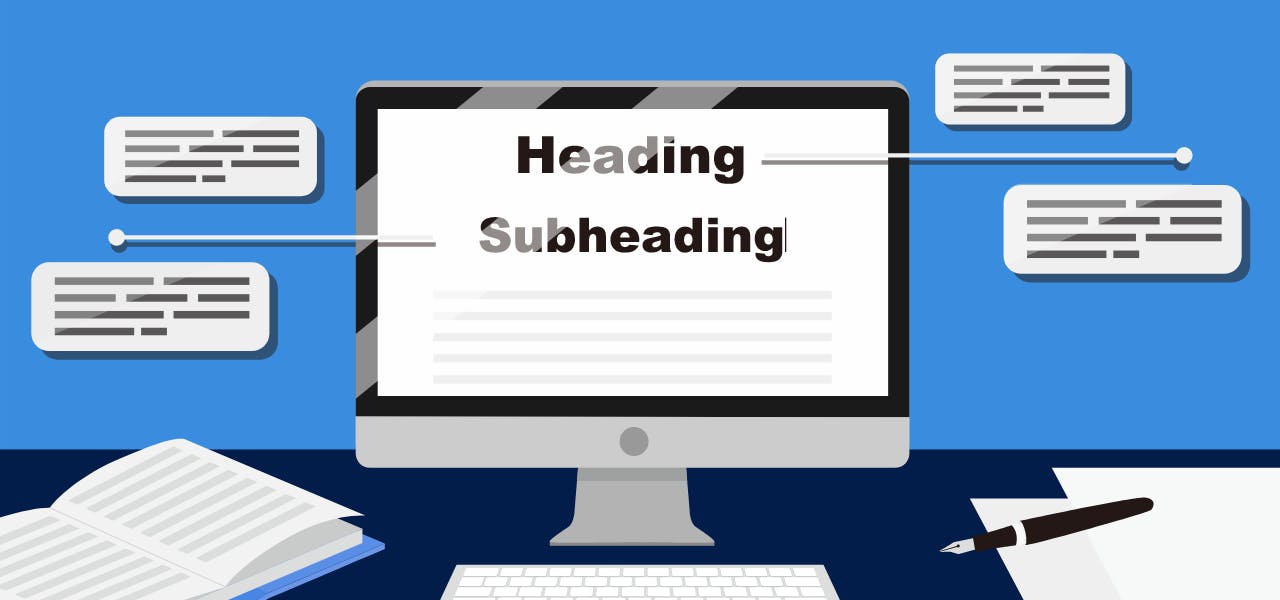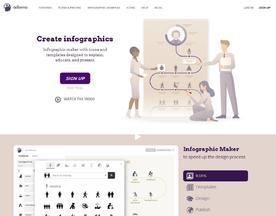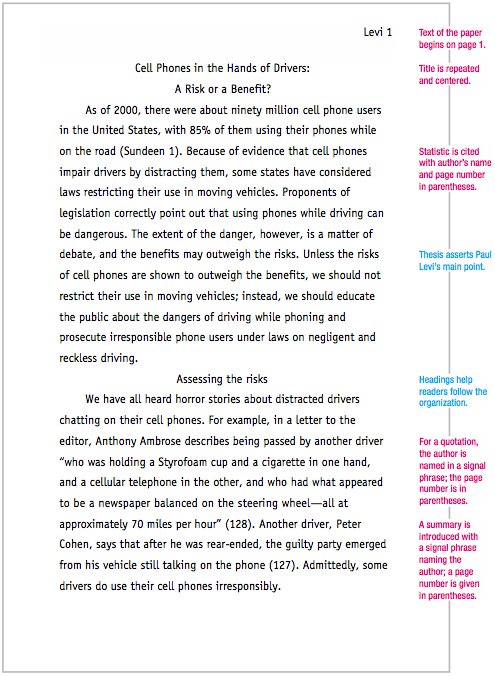- Comprehensive Guide to Headings and Subheadings in APA 7.0


Section 1: Introduction to Headings and Subheadings in APA 7.0-
In academic writing, the use of headings and subheadings is crucial for organizing and structuring a paper. APA (American Psychological Association) style, specifically in its 7th edition, provides clear guidelines on how to effectively use headings and subheadings to enhance readability and comprehensibility of research papers, essays, and other scholarly works. This section will provide a comprehensive introduction to the importance, purpose, and benefits of using headings and subheadings in APA 7.0 format.
Purpose of Headings and Subheadings
Headings and subheadings serve as visual cues to help readers navigate through the content of a paper. They create a hierarchical structure, indicating the relationships between different sections and subsections, and aid in organizing ideas and presenting information in a logical manner. By using headings and subheadings, writers can effectively divide their work into manageable and coherent sections, making it easier for readers to comprehend and follow the main arguments and supporting details.
Importance of Headings and Subheadings
Clear and well-structured headings and subheadings are essential in academic writing for several reasons. First and foremost, they enhance the overall readability of the paper by breaking down the text into smaller, digestible chunks. This organization allows readers to quickly identify and locate specific information, especially when they are scanning or skimming through the document.
Secondly, headings and subheadings contribute to the coherence and flow of the paper. By providing a clear roadmap, they guide the reader through the main ideas, supporting evidence, and key points presented in each section. This not only improves the overall structure of the paper but also helps maintain the logical progression of thoughts and arguments.
Additionally, headings and subheadings assist both readers and writers in comprehending complex topics. They enable writers to organize their thoughts, ensuring that each section focuses on a specific aspect or theme. This organization facilitates a deeper understanding of the subject matter for both the writer during the drafting process and the reader during the consumption of the paper.
Formatting Guidelines for Headings and Subheadings
APA 7.0 provides specific rules and formatting guidelines for using headings and subheadings. These guidelines include the use of different levels of headings, capitalization rules, and placement within the paper. Understanding and adhering to these guidelines is crucial for maintaining consistency and conformity with APA style.
The APA 7.0 formatting guidelines for headings and subheadings are based on a five-level hierarchy, with each level indicating the level of importance and hierarchy of information. Level 1 headings are the highest level, followed by Level 2, Level 3, and so on. Each level has a specific formatting style, such as font size, boldness, and indentation, to differentiate it from the other levels. Furthermore, APA 7.0 also provides guidance on the appropriate use of sentence case, title case, and capitalization in headings and subheadings. For instance, Level 1 headings are typically written in sentence case and are centered and bolded. Level 2 headings are aligned to the left margin, bolded, and written in title case. To maintain clarity and consistency, APA 7.0 also provides recommendations on the number of headings to use within a paper. It suggests that at least two headings should be used in any given section, as a single heading alone may not adequately represent the content covered.
Section 2: The Purpose and Importance of Headings and Subheadings in APA 7.0
Facilitating information retrieval.
One of the primary purposes of headings and subheadings in APA 7.0 is to facilitate information retrieval for readers. When faced with a lengthy document, readers often engage in scanning or skimming techniques to locate specific information or sections of interest. Well-structured headings and subheadings act as signposts, allowing readers to quickly identify the content they are seeking without having to read the entire text. By providing a clear and organized hierarchy, headings guide readers to the main sections of a paper, while subheadings further break down the content into more specific subsections. This hierarchical structure enables readers to navigate the document with ease, locating relevant information efficiently. Thus, headings and subheadings in APA 7.0 contribute significantly to the overall accessibility and user-friendliness of academic papers.
Enhancing Readability and Comprehensibility
Headings and subheadings play a vital role in enhancing the readability and comprehensibility of academic writing. They help break up large blocks of text into smaller, digestible sections, preventing the overwhelming feeling that dense paragraphs can create. By visually separating different sections and subsections, headings and subheadings allow readers to mentally prepare for the content they are about to encounter. Additionally, headings and subheadings improve the flow and coherence of a paper. They provide a roadmap for readers, helping them understand the organization and structure of the author's arguments and supporting evidence. Well-crafted headings and subheadings enable readers to follow the logical progression of ideas and maintain a clear understanding of the paper's main points. Finally, headings and subheadings aid in the comprehension of complex topics. By breaking down the content into smaller, focused sections, readers can grasp the material more easily. Headings act as cognitive cues, preparing readers for the information presented in each section. This approach not only facilitates understanding but also allows readers to engage with the content at a deeper level, promoting knowledge retention.
Organizing and Structuring Ideas
Headings and subheadings in APA 7.0 serve as valuable tools for organizing and structuring ideas within a paper. They help writers divide their work into meaningful sections, each addressing a specific aspect or theme related to the overall topic. This organization ensures that information is presented in a coherent and logical manner, making it easier for both the writer and the reader to navigate the paper.
By using headings and subheadings, writers can create a clear outline for their work, ensuring that each section has a distinct focus. This outline acts as a framework, guiding the writer in presenting their arguments and supporting evidence in a systematic and organized way. Writers can use headings to delineate major sections or main ideas, while subheadings allow for further subcategorization and exploration of subtopics.
Furthermore, headings and subheadings assist writers in structuring their thoughts during the writing process. By providing a visual representation of the paper's organization, headings help writers maintain a coherent flow of ideas and prevent the inclusion of irrelevant or tangential information. This structured approach not only improves the overall quality of the paper but also enhances the writer's ability to communicate their ideas effectively.
Conveying the Hierarchical Relationship of Information
Another important purpose of headings and subheadings in APA 7.0 is to convey the hierarchical relationship of information. By assigning different levels to headings, the writer can indicate the relative importance and order of ideas within the paper. Higher-level headings represent broader themes or major sections, while lower-level headings address more specific subtopics or subsections. This hierarchical structure helps readers understand the organization and logical flow of the paper at a glance. It allows them to grasp the overall structure and the relationships between different sections without having to read the entire document. Additionally, the use of indentation and formatting styles for each level of heading further reinforces the hierarchical relationship and aids in visual differentiation.
Section 3: Formatting Guidelines for Headings and Subheadings in APA 7.0
Proper formatting of headings and subheadings is crucial in APA 7.0 style to ensure consistency, clarity, and readability in academic writing. This section will delve into the specific formatting guidelines provided by APA 7.0 for headings and subheadings, including the use of different levels, capitalization rules, and placement within the paper.
Levels of Headings
APA 7.0 introduces a five-level hierarchy for headings, each denoting a different level of importance and significance within the paper. These levels provide a structured framework for organizing the content and help readers understand the organization and flow of ideas. Here are the five headings in APA 7.0:
Level 1: Centered, Bold and Title Case
Text begins here.
Level 2: Left-Aligned, Bold and Title Case
Level 3: Left-Aligned, Bold, Italics, and Title Case
Level 4: Left-Aligned, Bold, Title Case, and Period. Text begins here.
Level 5: Left-Aligned, Bold, Title Case, Italics, and Period . Text begins here.
Section 4: Organizing and Structuring Your Paper
Using headings and subheadings in apa 7.0.
Organizing and structuring your paper effectively is crucial for presenting your ideas in a logical and coherent manner. Headings and subheadings in APA 7.0 play a vital role in achieving this goal by providing a clear framework for organizing your content. This section will delve into strategies and best practices for utilizing headings and subheadings to organize and structure your paper in accordance with APA 7.0 guidelines.
Preparing an Outline
Before you begin writing your paper, it is helpful to create an outline that outlines the main sections and subsections you intend to cover. An outline acts as a roadmap, allowing you to visualize the overall structure and flow of your paper. It serves as a foundation for developing meaningful headings and subheadings that accurately represent the content and facilitate logical organization. Start by identifying the major sections that your paper will include, such as introduction, literature review, methods, results, discussion, and conclusion. These major sections will serve as Level 1 headings in APA 7.0. Next, break down each major section into subsections that address specific subtopics or aspects related to the main theme. These subsections will be represented by Level 2 headings. Depending on the complexity and depth of your paper, you may further divide the subsections into sub-subsections using Level 3, Level 4, and Level 5 headings. Creating a comprehensive outline not only helps you organize your thoughts but also ensures that you cover all the necessary components of your paper. It allows you to see the relationships between different sections and subsections, enabling you to present your arguments and evidence in a logical and coherent sequence.
Maintaining Consistency and Parallelism
Consistency is key when it comes to organizing and structuring your paper using headings and subheadings. It is important to establish a consistent framework that is followed throughout the entire document. Consistency ensures that readers can easily understand the hierarchy and relationships between different sections and subsections. When creating headings and subheadings, aim for parallelism in terms of grammatical structure and formatting. Parallelism means that headings at the same level should have a similar grammatical structure and formatting style. For instance, if you choose to use noun phrases for Level 2 headings, maintain this pattern consistently across all Level 2 headings in your paper. This helps readers navigate through the content smoothly and maintain a sense of coherence. Furthermore, parallelism extends to the use of punctuation and capitalization within headings and subheadings. Maintain consistent capitalization rules, such as sentence case for Level 1 headings and title case for Level 2 headings. This uniformity enhances the visual hierarchy and clarity of your paper.
Balancing Depth and Granularity
Effective organization and structuring involve finding the right balance between depth and granularity in your headings and subheadings. Level 1 headings represent major sections and should encapsulate broad themes or concepts, providing an overview of what will be discussed within each section. Level 2 headings, as subsections, delve into more specific topics or aspects related to the main theme of the major section.
Reviewing and Revising the Organization
Organizing and structuring your paper using headings and subheadings is not a one-time task. It is an iterative process that requires regular review and revision to ensure optimal clarity and coherence. Once you have completed the initial draft of your paper, review the organization of your headings and subheadings. Ask yourself if the structure effectively reflects the flow of your ideas and supports your main argument. Consider whether the headings accurately represent the content of each section and subsection. During the review process, pay attention to transitions between sections and subsections. Ensure that the headings and subheadings create a smooth transition from one topic to another, guiding readers through the logical progression of your paper. If you notice any gaps or inconsistencies, revise and refine the organization accordingly. Additionally, seek feedback from peers, mentors, or instructors. Their fresh perspective can provide valuable insights into the clarity and effectiveness of your headings and subheadings. Incorporate their feedback and make necessary adjustments to improve the overall organization and structure of your paper.
Section 5: Common Mistakes to Avoid in Using Headings and Subheadings in APA 7.0
While using headings and subheadings in APA 7.0 can greatly improve the organization and readability of your paper, it's important to be aware of common mistakes that can compromise the effectiveness of your headings. By understanding and avoiding these mistakes, you can ensure that your headings enhance the clarity and coherence of your academic writing. This section will explore some common mistakes to avoid when using headings and subheadings in APA 7.0.
Inconsistent Formatting
One of the most common mistakes is inconsistent formatting of headings and subheadings. In APA 7.0, it is crucial to maintain consistency in capitalization, alignment, and formatting styles across headings at the same level. Inconsistencies can confuse readers and disrupt the visual hierarchy of your paper. Ensure that all Level 1 headings have the same formatting, all Level 2 headings have the same formatting, and so on. Consistency in formatting contributes to the overall professionalism and readability of your work.
Poor Alignment and Spacing
Another mistake to avoid is incorrect alignment and spacing of headings and subheadings. In APA 7.0, Level 1 headings are centered and typically start on a new page or a new line with an extra line space before and after the heading. Level 2 headings and lower-level headings, however, are left-aligned and generally require an extra line space before the heading but not after. Failure to align and space headings correctly can create confusion and disrupt the logical flow of your paper. Review APA 7.0 guidelines carefully to ensure proper alignment and spacing of your headings.
Lack of Parallelism
Parallelism, or consistent grammatical structure, is crucial when using headings and subheadings. Headings at the same level should follow a similar structure to maintain coherence and readability. For example, if you use noun phrases for Level 2 headings, ensure that all Level 2 headings follow this pattern. Lack of parallelism can make your headings appear disjointed and may confuse readers. Consistently apply parallel structure within each level of headings to create a smooth and organized flow of information.
Overcomplicating the Heading Structure
While it is important to provide a clear and hierarchical structure to your paper, overcomplicating the heading structure can lead to confusion and excessive fragmentation. Strive to find a balance between providing enough detail to cover your content effectively and avoiding an excessive number of headings and subheadings. Each heading should represent a meaningful subdivision and contribute to the overall organization and coherence of your paper. Aim for a clear and concise heading structure that guides readers without overwhelming them with excessive levels or overly specific subdivisions.
Lack of Descriptiveness
Headings and subheadings should be descriptive and informative to accurately represent the content covered within each section. Avoid using generic or ambiguous headings that do not provide a clear indication of what readers can expect to find. Vague headings can leave readers uncertain about the content or make it challenging to locate specific information within your paper. Ensure that your headings succinctly capture the main ideas or themes of each section, guiding readers through your content effectively.
Ignoring the Reader's Perspective
When creating headings and subheadings, it's important to consider the perspective of your readers. Put yourself in their shoes and think about how your headings will facilitate their understanding and navigation through your paper. Consider whether your headings effectively communicate the main points, guide readers through the logical flow of your arguments, and enable them to locate specific information easily. Ignoring the reader's perspective can result in headings that are unclear, unhelpful, or inconsistent, hindering the overall readability and comprehension of your work.
Neglecting to Revise and Edit Headings
Headings should not be an afterthought or treated as static elements in your paper. Neglecting to revise and edit your headings can lead to inaccuracies, lack of clarity, or poor alignment with the final content of your paper. As you progress through the writing process, continuously review and refine your headings to ensure they accurately represent the content and flow of your arguments. Make necessary adjustments, reword headings for better clarity, and ensure that they align with the finalized structure and organization of your paper.
Recent Posts

How to Write an Academic Paper

Finding the Right Statistical Service for Your Academic Needs

Exercise and Academic Writing

Understanding Heteroskedasticity in OLS Regression
Have any questions?
Our support team is ready to answer your questions.
Help Center FAQ
To mark our first year, we've slashed all our prices in half. Order now to seize this limited opportunity!
Place Your Order
- Affiliate Program

- UNITED STATES
- 台灣 (TAIWAN)
- TÜRKIYE (TURKEY)
- Academic Editing Services
- - Research Paper
- - Journal Manuscript
- - Dissertation
- - College & University Assignments
- Admissions Editing Services
- - Application Essay
- - Personal Statement
- - Recommendation Letter
- - Cover Letter
- - CV/Resume
- Business Editing Services
- - Business Documents
- - Report & Brochure
- - Website & Blog
- Writer Editing Services
- - Script & Screenplay
- Our Editors
- Client Reviews
- Editing & Proofreading Prices
- Wordvice Points
- Partner Discount
- Plagiarism Checker
- APA Citation Generator
- MLA Citation Generator
- Chicago Citation Generator
- Vancouver Citation Generator
- - APA Style
- - MLA Style
- - Chicago Style
- - Vancouver Style
- Writing & Editing Guide
- Academic Resources
- Admissions Resources
Formatting Research Paper Headings and Subheadings
Different style guides have different rules regarding the formatting of headings and subheadings in a paper, but what information you should actually put into your subheadings is a different question and often up to personal taste. Here we quickly summarize general guidelines, different approaches, and what not to do when choosing headings for a research paper.
Does it matter how I name my sections and subsections?
The main sections of a research paper have general headers and are often journal-specific, but some (e.g., the methods and discussion section) can really benefit from subsections with clear and informative headers. The things to keep in mind are thus the general style your paper is supposed to follow (e.g., APA, MLA), the specific guidelines the journal you want to submit to lists in their author instructions , and your personal style (e.g., how much information you want the reader to get from just reading your subsection headers).
Table of Contents:
- Style Guides: Rules on Headings and Subheadings
- What Sections and Subsections Do You Need?
- How Should You Name Your Sections and Subsections?
- Avoid These Common Mistakes

Style Guides: Research Paper Heading and Subheading Format
Headers identify the content within the different sections of your paper and should be as descriptive and concise as possible. That is why the main sections of research articles always have the same or very similar headers ( Introduction, Methods, Results, Discussion ), with no or only small differences between journals. However, you also need to divide the content of some of these sections (e.g., the method section) into smaller subsections (e.g., Participants, Experimental Design, and Statistical Analysis ), and make sure you follow specific journal formatting styles when doing so.
If the journal you submit to follows APA style , for example, you are allowed to use up to five levels of headings, depending on the length of your paper, the complexity of your work, and your personal preference. To clearly indicate how each subsection fits into the rest of the text, every header level has a different format – but note that headers are usually not numbered because the different formatting already reflects the text hierarchy.
APA style headings example structure
Level 1 Centered, Bold, Title Case
Text begins as a new paragraph.
Level 2 Left-aligned, Bold, Title Case
Level 3 Left-aligned, Bold Italic, Title Case
Level 4 Indented, Bold, Title Case, Period . Text begins on the same
line and continues as a regular paragraph.
Level 5 Indented, Bold Italic, Title Case, Period. Text begins on the
same line and continues as a regular paragraph.
If you only need one section header (e.g. Methods ) and one level of subsection headers (e.g., Participants, Experimental Design, and Statistical Analysis ), use Level 1 and Level 2 headers. If you need three levels of headings, use Levels 1, 2, and 3 (and so on). Do not skip levels or combine them in a different way.
If you write a paper in Chicago style or MLA style , then you don’t need to follow such exact rules for headings and subheadings. Your structure just has to be consistent with the general formatting guidelines of both styles (12-pts Times New Roman font, double-spaced text, 0.5-inch indentation for every new paragraph) and consistent throughout your paper. Make sure the different formatting levels indicate a hierarchy (e.g., boldface for level 1 and italics for level 2, or a larger font size for level 1 and smaller font size for level 2). The main specifics regarding Chicago and MLA headings and subheadings are that they should be written in title case (major words capitalized, most minor words lowercase) and not end in a period. Both styles allow you, however, to number your sections and subsections, for example with an Arabic number and a period, followed by a space and then the section name.
MLA paper headings example structure
1. Introduction
2. Material and Methods
2.1 Subject Recruitment
2.2 Experimental Procedure
2.3 Statistical Analysis
3.1 Experiment 1
3.2 Experiment 2
4. Discussion
5. Conclusion
What research paper headings do you need?
Your paper obviously needs to contain the main sections ( Introduction, Methods, Results, Discussion, and maybe Conclusion ) and you need to make sure that you name them according to the target journal style (have a look at the author guidelines if you are unsure what the journal style is). The differences between journals are subtle, but some want you to combine the results and discussion sections, for example, while others don’t want you to have a separate conclusion section. You also need to check whether the target journal has specific rules on subsections (or no subsections) within these main sections. The introduction section should usually not be subdivided (but some journals do not mind), while the method section, for example, always needs to have clear subsections.
How to Name Your Sections and Subsections
The method section subheadings should be short and descriptive, but how you subdivide this section depends on the structure you choose to present your work – which can be chronological (e.g., Experiment 1, Experiment 2 ) or follow your main topics (e.g., Visual Experiment, Behavioral Experiment, Questionnaire ). Have a look at this article on how to write the methods for a research paper if you need input on what the best structure for your work is. The method subheadings should only be keywords that tell the reader what information is following, not summaries or conclusions. That means that “ Subject Recruitment ” is a good methods section subheading, but “ Subjects Were Screened Using Questionnaires ” is not.
The subheadings for the result section should then follow the general structure of your method section, but here you can choose what information you want to put in every subheading. Some authors keep it simple and just subdivide their result section into experiments or measures like the method section, but others use the headings to summarize their findings so that the reader is prepared for the details that follow. You could, for example, simply name your subsections “ Anxiety Levels ” and “ Social Behavior ,” if those are the measures you studied and explained in the method section.
Or, you could provide the reader with a glimpse into the results of the analyses you are going to describe, and instead name these subsections “ Anxiety-Like Behaviors in Mutant Mice ” and “ Normal Social Behaviors in Mutant Mice .” While keeping headings short and simple is always a good idea, such mini-summaries can make your result section much clearer and easier to follow. Just make sure that the target journal you want to submit to does not have a rule against that.
Common Heading and Subheading Mistakes
Subheadings are not sentences.
If your heading reads like a full sentence, then you can most probably omit the verb or generally rephrase to shorten it. That also means a heading should not contain punctuation except maybe colons or question marks – definitely don’t put a period at the end, except when you have reached heading level 4 in the APA formatting style (see above) and the rules say so.
Be consistent
Always check your numbering, for example for spaces and periods before and after numbers (e.g., 3.2. vs 3.2 ), because readability depends on such features. But also make sure that your headings are consistent in structure and content: Switching between short keyword headings (e.g., “ Experiment 2 ”) and summary headings (e.g., “ Mice Do not Recognize People ”) is confusing and never a good idea. Ideally, subheadings within a section all have a similar structure. If your first subsection is called “ Mice Do not Recognize People ,” then “ People Do not Recognize Mice” is a better subheader for the next subsection than “Do People Recognize Mice? ”, because consistency is more important in a research paper than creativity.
Don’t overdo it
Not every paragraph or every argument needs a subheading. Only use subheadings within a bigger section if you have more than one point to make per heading level, and if subdividing the section really makes the structure clearer overall.
Before submitting your journal manuscript to academic publishers, be sure to get English editing services , including manuscript editing or paper editing from a trusted source. And receive instant proofreading with Wordvice AI, our AI online text editor , which provides unlimited editing while drafting your research work.
How do I style headings and subheadings in a research paper?
Headings and subheadings can help organize and structure your writing. In general, longer and more complex works warrant more of them than shorter ones. Avoid overusing headings in short projects; they should never be used to compensate for poor structure or to explain an underdeveloped idea.
When headings are called for in your writing project, observe the basic guidelines below.
The paper or chapter title is the first level of heading, and it must be the most prominent.
Headings should be styled in descending order of prominence. After the first level, the other headings are subheadings—that is, they are subordinate. Font styling and size are used to signal prominence. In general, a boldface, larger font indicates prominence; a smaller font, italics, and lack of bold can be used to signal subordination. For readability, don’t go overboard: avoid using all capital letters for headings (in some cases, small capitals may be acceptable):
Heading Level 1
Heading Level 2
Heading Level 3
Note that word-processing software often has built-in heading styles.
Consistency
Consistency in the styling of headings and subheadings is key to signaling to readers the structure of a research project. That is, each level 1 heading should appear in the same style and size, as should each level 2 heading, and so on. Generally avoid numbers and letters to designate heads unless you are working in a discipline where doing so is conventional. Note that a heading labeled “1” requires a subsequent heading labeled “2,” and a heading labeled “a” requires a subsequent heading labeled “b.”
In a project that is not professionally designed and published, headings should be flush with the left margin, to avoid confusion with block quotations. (The exception is the paper or chapter title, which is centered in MLA style.)
For readability, it is helpful to include a line space above and below a heading, as shown in this post.
No internal heading level should have only one instance. For example, if you have one level 1 heading, you need to have a second level 1 heading. (The exceptions are the paper or chapter title and the headings for notes and the list of works cited.) You should also generally have text under each heading.
Capitalization
Capitalize headings like the titles of works, as explained in section 1.5 of the MLA Handbook .
The shorter, the better.
Table of Contents
Collaboration, information literacy, writing process, apa headings and subheadings.
- © 2023 by Jennifer Janechek - IBM Quantum
- headings when there are at least two subsections within a larger section.
- using subheadings only when the paper has at least two subsections within a larger section
APA headings and subheadings refers to the rules for formatting sections of documents in the 7th Edition of the American Psychological Association’s Publication Manual .
A research paper written in APA style should be organized into sections and subsections using the five levels of APA headings.
Related Concepts:
Notice how sections contain at least two smaller subsections in the example below:
Design
Participants. , demographics..
Characteristics.
Limitations
Starting with the first level of heading, the subsections of the paper should progressively use the next level(s) of heading without skipping any levels. Major sections of the paper’s main body, including the Method, Results, and Discussion sections, should always be formatted with the first level of heading. However, keep in mind that the Introduction section, which is preceded by the full title of the paper, should be presented in plain type. Any subsections that fall under the major sections are formatted with the next level of heading.
Note that all paragraphs of the main body, including those that fall under subsections of a larger section, still maintain the pattern of indentation, use Times New Roman font, 12 pt., and are double-spaced. There are no extra lines or spaces between paragraphs and headings.
How are the five levels of APA-style headings formatted?
Format each of the five levels of APA-style headings as demonstrated in the example below. Note that while the example features headings titled “First Level,” “Second Level,” and so on, each heading in your paper should be named according to the section it describes.
First level
The first level of heading is bolded and centered, and the first letter of each word in the heading is capitalized. The paragraph text should be typed on the following line and indented five spaces from the left.
Second level
The second level of heading is bolded and situated flush left, and the first letter of each word in the heading is capitalized. The paragraph text should be typed on the following line and indented five spaces from the left.
Third level
The third level of heading is bolded, indented five spaces from the left, and followed by a period. Capitalize only the first letter of the first word in the heading and of proper nouns. The first paragraph following this heading should be typed on the same line as the heading.
Fourth level
The fourth level of heading is bolded, italicized, indented five spaces from the left, and followed by a period. Capitalize only the first letter of the first word in the heading and of proper nouns. The first paragraph following this heading should be typed on the same line as the heading.
Fifth level
The fifth level of heading is italicized, indented five spaces from the left, and followed by a period. Capitalize only the first letter of the first word in the heading and of proper nouns. The first paragraph following this heading should be typed on the same line as the heading.
Method (1st level)
Design (2nd level)
Participants (3rd level)
Demographics. (4th level)
Age Group. (5th level)
Limitations (2nd level)
- For student papers, include only the page number in the top right margin of every page of the paper
- For professional papers, place the page number in the top right margin and the running head in the top left margin of every page of the paper. Running heads should be a shortened version of the paper title.

Brevity - Say More with Less

Clarity (in Speech and Writing)

Coherence - How to Achieve Coherence in Writing

Flow - How to Create Flow in Writing

Inclusivity - Inclusive Language

The Elements of Style - The DNA of Powerful Writing

Suggested Edits
- Please select the purpose of your message. * - Corrections, Typos, or Edits Technical Support/Problems using the site Advertising with Writing Commons Copyright Issues I am contacting you about something else
- Your full name
- Your email address *
- Page URL needing edits *
- Email This field is for validation purposes and should be left unchanged.
Other Topics:

Citation - Definition - Introduction to Citation in Academic & Professional Writing
- Joseph M. Moxley
Explore the different ways to cite sources in academic and professional writing, including in-text (Parenthetical), numerical, and note citations.

Collaboration - What is the Role of Collaboration in Academic & Professional Writing?
Collaboration refers to the act of working with others or AI to solve problems, coauthor texts, and develop products and services. Collaboration is a highly prized workplace competency in academic...

Genre may reference a type of writing, art, or musical composition; socially-agreed upon expectations about how writers and speakers should respond to particular rhetorical situations; the cultural values; the epistemological assumptions...

Grammar refers to the rules that inform how people and discourse communities use language (e.g., written or spoken English, body language, or visual language) to communicate. Learn about the rhetorical...

Information Literacy - Discerning Quality Information from Noise
Information Literacy refers to the competencies associated with locating, evaluating, using, and archiving information. In order to thrive, much less survive in a global information economy — an economy where information functions as a...

Mindset refers to a person or community’s way of feeling, thinking, and acting about a topic. The mindsets you hold, consciously or subconsciously, shape how you feel, think, and act–and...

Rhetoric: Exploring Its Definition and Impact on Modern Communication
Learn about rhetoric and rhetorical practices (e.g., rhetorical analysis, rhetorical reasoning, rhetorical situation, and rhetorical stance) so that you can strategically manage how you compose and subsequently produce a text...

Style, most simply, refers to how you say something as opposed to what you say. The style of your writing matters because audiences are unlikely to read your work or...

The Writing Process - Research on Composing
The writing process refers to everything you do in order to complete a writing project. Over the last six decades, researchers have studied and theorized about how writers go about...

Writing Studies
Writing studies refers to an interdisciplinary community of scholars and researchers who study writing. Writing studies also refers to an academic, interdisciplinary discipline – a subject of study. Students in...
Featured Articles

Academic Writing – How to Write for the Academic Community

Professional Writing – How to Write for the Professional World

Authority – How to Establish Credibility in Speech & Writing

Want to create or adapt books like this? Learn more about how Pressbooks supports open publishing practices.
13.1 Formatting a Research Paper
Learning objectives.
- Identify the major components of a research paper written using American Psychological Association (APA) style.
- Apply general APA style and formatting conventions in a research paper.
In this chapter, you will learn how to use APA style , the documentation and formatting style followed by the American Psychological Association, as well as MLA style , from the Modern Language Association. There are a few major formatting styles used in academic texts, including AMA, Chicago, and Turabian:
- AMA (American Medical Association) for medicine, health, and biological sciences
- APA (American Psychological Association) for education, psychology, and the social sciences
- Chicago—a common style used in everyday publications like magazines, newspapers, and books
- MLA (Modern Language Association) for English, literature, arts, and humanities
- Turabian—another common style designed for its universal application across all subjects and disciplines
While all the formatting and citation styles have their own use and applications, in this chapter we focus our attention on the two styles you are most likely to use in your academic studies: APA and MLA.
If you find that the rules of proper source documentation are difficult to keep straight, you are not alone. Writing a good research paper is, in and of itself, a major intellectual challenge. Having to follow detailed citation and formatting guidelines as well may seem like just one more task to add to an already-too-long list of requirements.
Following these guidelines, however, serves several important purposes. First, it signals to your readers that your paper should be taken seriously as a student’s contribution to a given academic or professional field; it is the literary equivalent of wearing a tailored suit to a job interview. Second, it shows that you respect other people’s work enough to give them proper credit for it. Finally, it helps your reader find additional materials if he or she wishes to learn more about your topic.
Furthermore, producing a letter-perfect APA-style paper need not be burdensome. Yes, it requires careful attention to detail. However, you can simplify the process if you keep these broad guidelines in mind:
- Work ahead whenever you can. Chapter 11 “Writing from Research: What Will I Learn?” includes tips for keeping track of your sources early in the research process, which will save time later on.
- Get it right the first time. Apply APA guidelines as you write, so you will not have much to correct during the editing stage. Again, putting in a little extra time early on can save time later.
- Use the resources available to you. In addition to the guidelines provided in this chapter, you may wish to consult the APA website at http://www.apa.org or the Purdue University Online Writing lab at http://owl.english.purdue.edu , which regularly updates its online style guidelines.
General Formatting Guidelines
This chapter provides detailed guidelines for using the citation and formatting conventions developed by the American Psychological Association, or APA. Writers in disciplines as diverse as astrophysics, biology, psychology, and education follow APA style. The major components of a paper written in APA style are listed in the following box.
These are the major components of an APA-style paper:
Body, which includes the following:
- Headings and, if necessary, subheadings to organize the content
- In-text citations of research sources
- References page
All these components must be saved in one document, not as separate documents.
The title page of your paper includes the following information:
- Title of the paper
- Author’s name
- Name of the institution with which the author is affiliated
- Header at the top of the page with the paper title (in capital letters) and the page number (If the title is lengthy, you may use a shortened form of it in the header.)
List the first three elements in the order given in the previous list, centered about one third of the way down from the top of the page. Use the headers and footers tool of your word-processing program to add the header, with the title text at the left and the page number in the upper-right corner. Your title page should look like the following example.

The next page of your paper provides an abstract , or brief summary of your findings. An abstract does not need to be provided in every paper, but an abstract should be used in papers that include a hypothesis. A good abstract is concise—about one hundred fifty to two hundred fifty words—and is written in an objective, impersonal style. Your writing voice will not be as apparent here as in the body of your paper. When writing the abstract, take a just-the-facts approach, and summarize your research question and your findings in a few sentences.
In Chapter 12 “Writing a Research Paper” , you read a paper written by a student named Jorge, who researched the effectiveness of low-carbohydrate diets. Read Jorge’s abstract. Note how it sums up the major ideas in his paper without going into excessive detail.

Write an abstract summarizing your paper. Briefly introduce the topic, state your findings, and sum up what conclusions you can draw from your research. Use the word count feature of your word-processing program to make sure your abstract does not exceed one hundred fifty words.
Depending on your field of study, you may sometimes write research papers that present extensive primary research, such as your own experiment or survey. In your abstract, summarize your research question and your findings, and briefly indicate how your study relates to prior research in the field.
Margins, Pagination, and Headings
APA style requirements also address specific formatting concerns, such as margins, pagination, and heading styles, within the body of the paper. Review the following APA guidelines.
Use these general guidelines to format the paper:
- Set the top, bottom, and side margins of your paper at 1 inch.
- Use double-spaced text throughout your paper.
- Use a standard font, such as Times New Roman or Arial, in a legible size (10- to 12-point).
- Use continuous pagination throughout the paper, including the title page and the references section. Page numbers appear flush right within your header.
- Section headings and subsection headings within the body of your paper use different types of formatting depending on the level of information you are presenting. Additional details from Jorge’s paper are provided.

Begin formatting the final draft of your paper according to APA guidelines. You may work with an existing document or set up a new document if you choose. Include the following:
- Your title page
- The abstract you created in Note 13.8 “Exercise 1”
- Correct headers and page numbers for your title page and abstract
APA style uses section headings to organize information, making it easy for the reader to follow the writer’s train of thought and to know immediately what major topics are covered. Depending on the length and complexity of the paper, its major sections may also be divided into subsections, sub-subsections, and so on. These smaller sections, in turn, use different heading styles to indicate different levels of information. In essence, you are using headings to create a hierarchy of information.
The following heading styles used in APA formatting are listed in order of greatest to least importance:
- Section headings use centered, boldface type. Headings use title case, with important words in the heading capitalized.
- Subsection headings use left-aligned, boldface type. Headings use title case.
- The third level uses left-aligned, indented, boldface type. Headings use a capital letter only for the first word, and they end in a period.
- The fourth level follows the same style used for the previous level, but the headings are boldfaced and italicized.
- The fifth level follows the same style used for the previous level, but the headings are italicized and not boldfaced.
Visually, the hierarchy of information is organized as indicated in Table 13.1 “Section Headings” .
Table 13.1 Section Headings
A college research paper may not use all the heading levels shown in Table 13.1 “Section Headings” , but you are likely to encounter them in academic journal articles that use APA style. For a brief paper, you may find that level 1 headings suffice. Longer or more complex papers may need level 2 headings or other lower-level headings to organize information clearly. Use your outline to craft your major section headings and determine whether any subtopics are substantial enough to require additional levels of headings.
Working with the document you developed in Note 13.11 “Exercise 2” , begin setting up the heading structure of the final draft of your research paper according to APA guidelines. Include your title and at least two to three major section headings, and follow the formatting guidelines provided above. If your major sections should be broken into subsections, add those headings as well. Use your outline to help you.
Because Jorge used only level 1 headings, his Exercise 3 would look like the following:
Citation Guidelines
In-text citations.
Throughout the body of your paper, include a citation whenever you quote or paraphrase material from your research sources. As you learned in Chapter 11 “Writing from Research: What Will I Learn?” , the purpose of citations is twofold: to give credit to others for their ideas and to allow your reader to follow up and learn more about the topic if desired. Your in-text citations provide basic information about your source; each source you cite will have a longer entry in the references section that provides more detailed information.
In-text citations must provide the name of the author or authors and the year the source was published. (When a given source does not list an individual author, you may provide the source title or the name of the organization that published the material instead.) When directly quoting a source, it is also required that you include the page number where the quote appears in your citation.
This information may be included within the sentence or in a parenthetical reference at the end of the sentence, as in these examples.
Epstein (2010) points out that “junk food cannot be considered addictive in the same way that we think of psychoactive drugs as addictive” (p. 137).
Here, the writer names the source author when introducing the quote and provides the publication date in parentheses after the author’s name. The page number appears in parentheses after the closing quotation marks and before the period that ends the sentence.
Addiction researchers caution that “junk food cannot be considered addictive in the same way that we think of psychoactive drugs as addictive” (Epstein, 2010, p. 137).
Here, the writer provides a parenthetical citation at the end of the sentence that includes the author’s name, the year of publication, and the page number separated by commas. Again, the parenthetical citation is placed after the closing quotation marks and before the period at the end of the sentence.
As noted in the book Junk Food, Junk Science (Epstein, 2010, p. 137), “junk food cannot be considered addictive in the same way that we think of psychoactive drugs as addictive.”
Here, the writer chose to mention the source title in the sentence (an optional piece of information to include) and followed the title with a parenthetical citation. Note that the parenthetical citation is placed before the comma that signals the end of the introductory phrase.
David Epstein’s book Junk Food, Junk Science (2010) pointed out that “junk food cannot be considered addictive in the same way that we think of psychoactive drugs as addictive” (p. 137).
Another variation is to introduce the author and the source title in your sentence and include the publication date and page number in parentheses within the sentence or at the end of the sentence. As long as you have included the essential information, you can choose the option that works best for that particular sentence and source.
Citing a book with a single author is usually a straightforward task. Of course, your research may require that you cite many other types of sources, such as books or articles with more than one author or sources with no individual author listed. You may also need to cite sources available in both print and online and nonprint sources, such as websites and personal interviews. Chapter 13 “APA and MLA Documentation and Formatting” , Section 13.2 “Citing and Referencing Techniques” and Section 13.3 “Creating a References Section” provide extensive guidelines for citing a variety of source types.
Writing at Work
APA is just one of several different styles with its own guidelines for documentation, formatting, and language usage. Depending on your field of interest, you may be exposed to additional styles, such as the following:
- MLA style. Determined by the Modern Languages Association and used for papers in literature, languages, and other disciplines in the humanities.
- Chicago style. Outlined in the Chicago Manual of Style and sometimes used for papers in the humanities and the sciences; many professional organizations use this style for publications as well.
- Associated Press (AP) style. Used by professional journalists.
References List
The brief citations included in the body of your paper correspond to the more detailed citations provided at the end of the paper in the references section. In-text citations provide basic information—the author’s name, the publication date, and the page number if necessary—while the references section provides more extensive bibliographical information. Again, this information allows your reader to follow up on the sources you cited and do additional reading about the topic if desired.
The specific format of entries in the list of references varies slightly for different source types, but the entries generally include the following information:
- The name(s) of the author(s) or institution that wrote the source
- The year of publication and, where applicable, the exact date of publication
- The full title of the source
- For books, the city of publication
- For articles or essays, the name of the periodical or book in which the article or essay appears
- For magazine and journal articles, the volume number, issue number, and pages where the article appears
- For sources on the web, the URL where the source is located
The references page is double spaced and lists entries in alphabetical order by the author’s last name. If an entry continues for more than one line, the second line and each subsequent line are indented five spaces. Review the following example. ( Chapter 13 “APA and MLA Documentation and Formatting” , Section 13.3 “Creating a References Section” provides extensive guidelines for formatting reference entries for different types of sources.)

In APA style, book and article titles are formatted in sentence case, not title case. Sentence case means that only the first word is capitalized, along with any proper nouns.
Key Takeaways
- Following proper citation and formatting guidelines helps writers ensure that their work will be taken seriously, give proper credit to other authors for their work, and provide valuable information to readers.
- Working ahead and taking care to cite sources correctly the first time are ways writers can save time during the editing stage of writing a research paper.
- APA papers usually include an abstract that concisely summarizes the paper.
- APA papers use a specific headings structure to provide a clear hierarchy of information.
- In APA papers, in-text citations usually include the name(s) of the author(s) and the year of publication.
- In-text citations correspond to entries in the references section, which provide detailed bibliographical information about a source.
Writing for Success Copyright © 2015 by University of Minnesota is licensed under a Creative Commons Attribution-NonCommercial-ShareAlike 4.0 International License , except where otherwise noted.
- Forgot your Password?
- Create an Account
APA Headings: Key to Academic Achievement and Recognition

Content without proper structure and heading is like a road without traffic rules. Your reader will get distracted and need clarification trying to find an easy way out of reading your paper. APA style formatting is a popular way to structure academic writing because it’s easy to understand both by readers and writers.
Most teachers prefer the use of APA formatting due to its simple and manageable rules. Whether you are writing a college essay or a research paper, this guide on proper APA heading and formatting will direct you to craft well-oriented, presentable, and reader-friendly content. So, continue reading.
Table of Contents
What are APA Headings?
The American Psychological Association (APA) employs a standardized format for composing research papers, which is commonly utilized in social sciences and humanities fields such as psychology, sociology, linguistics, and more. Understanding APA format is crucial, particularly when considering how to write an 8-page paper in these disciplines. APA essay heading is way to format your paper in a style that’s acceptable to the rules and guidelines of college or university you’re writing for.
An APA paper is divided into different sections to help the reader understand the content. All of the sections are given different levels of headlines to organize the research further and make it more digestible. There are other benefits of these headlines that you will find more about below. But first, let’s discuss the levels of these seriation APA headings.
APA Headings: Levels, Format, and Usage
Before you write a paper , it’s important to know how to enhance your research paper format. Here is a proper tutorial on these headlines’ levels, format, and usage.
Levels and Usage of APA Headings and Subheadings:
There are five different levels of APA headings that you can use to help your reader to navigate through your paper. It’s up to the writer to choose how many headlines they want to incorporate in one section of their paper. Some APA papers have three headings, yet others have all five.
Further, in some research paper examples, different sections may use varying numbers of headlines, with three in major sections and all five in another. This allows writers to structure their content in a way that best suits their needs and helps readers to follow along easily.
Following are the five levels of these APA headlines and their specific roles such as in APA conclusion heading:
Changes in APA Headings Format: 6th and 7th Edition
With time the American Psychological Association updates the APA format to make it more reader-friendly. The 7th edition of the APA publication guide has several updates that make it more useful for students, teachers, and other educational participants.
As the APA 7th edition includes numerous changes compared to the previous edition, we will only focus on how the header levels APA format has changed. Below is a chart that compares and highlights both differences and both editions.
- Title Case Capitalization : capitalize all the major words, including all adverbs, nouns, adjectives, verbs, pronouns, and conjunctions.
One rule of thumb is “all words longer than four letters”. Yet sometimes, even the articles (a, an, the) are capitalized.
- Proper nouns
- The first word after a dash, colon, or end punctuation
- First word of subtitles
- Nouns used after numerals or letters

APA Headings and Formatting: Advantages in Academic Writing
Employing proper formatting techniques acts as one of the secret weapons to elevate the professionalism and refinement of your academic paper, especially when discussing finance research topics . It not just creates a positive impression on the reader, but they also find your content more digestible.
There are several other reasons and advantages of using the APA style format, but before we dive into that, let’s explore where we can use this style of seriation.
Use of APA Heading Format in Academics
Research paper: .
Research papers are often difficult to understand due to their complex sentences and technical vocabulary. Without proper structure and seriation, these papers would be a pile of unreadable waste. Thus, using APA formatting can enhance readability, presenting the finding clearly and coherently. One helpful exercise to improve formatting skills is to read different research paper examples and transform them into APA paper examples.
Case Studies:
Case studies analyze different circumstances and scenarios to illustrate certain theses and can be quite technical. To make it more reader-friendly, one can use APA style formatting and headings to organize the different sections of the study. These can include background, methodology, results, and discussion.
Literature Reviews:
A literature review is a lengthy document or a section that illustrates key conversational sources and an overview of the available knowledge of a topic. APA style formatting can enhance the organization and presentation of a literature review.
Essays are the most common academic writings. They explore various topics and provide different arguments on particular subjects. An APA essay format can organize content into easily digestible sections. This arrangement tactic is helpful for both the reader and the writer.
Thesis and Dissertations:
Most university students are assigned to write their thesis, which is a lengthy research paper. A dissertation is lengthier still, and most students joke about how only APA headers can keep track of their writing. Understanding how long should a research paper be becomes crucial in these academic endeavours. APA headings and format can help students boost these detailed papers. These academic writings can be structured into sections and subsections.
In addition to the previously mentioned benefits, APA formatting has several advantages for both students and teachers in academic writing.
Benefits of Using APA Headings in Academic Writing
Using a proper structure tactic is very effective regarding the quality and credibility of your paper. So here are some benefits of adopting APA structuring as practice in your academic writing.
Arrangement:
APA headings and formatting provide a clear, meaningful structure that enhances a paper. The use of headings and subheadings can help divide the content into smaller chunks, making it more manageable to read, write, and understand. Moreover, it assists the reader in keeping track of the information they can extract from a particular academic paper.
APA research paper format helps in creating precision in writing and information. It can also help the reader to locate the specific information they are looking for in a paper. Proper formatting and the use of a running APA header enhance the connectivity of the information provided.
Consistency:
Reading a good example of an APA paper will make you realize the importance of using a consistent framework and organization in written content. By following the APA guideline, a writer can polish their work and make it appear more professional.
Navigation:
APA seriation makes it easier for the reader to navigate through lengthy theses and dissertations. They can skim the paper by skipping the headline or subheadings that do not interest them.
Readability:
Your reader is more likely to stay focused on what they are reading if they find your content manageable. The use of APA formatting can make your content appear reader-friendly and keep them engaged till the very end, thus, increasing the overall readability.
Additional Technical Writing Tips for APA headings
There are additional tips that will always help you
- Always keep in close contact with your supervisor or instructor, especially when it comes to writing longer documents like dissertations . There is a chance you might be required to number your headings.
- Avoid the use of numbers and letters in your headings and subsections.
- Avoid creating extra space both above and below the headings.
- Avoid the change of font between body and headings (e.g., Times New Roman)
- Double-space your heading along with the headings.
The American Psychological Association (APA) formatting style can help you create polished papers. A smart use of APA headings and their various levels will assist you in bridging the gap between okay and excellent research. Learning to use a whole format, especially at the last minute of your submission, may be impossible. But what’s possible is selecting an exceptional research paper writing service that helps you succeed each time. Our top-notch team of seasoned professionals will guide you through the darkest tunnels with their wands of influential words. So reach out now to customize your essays and paper assignments at student-oriented discounts.
Order Original Papers & Essays
Your First Custom Paper Sample is on Us!
Timely Deliveries
No Plagiarism & AI
100% Refund
Try Our Free Paper Writing Service
Related blogs.

Connections with Writers and support
Privacy and Confidentiality Guarantee
Average Quality Score
- Discoveries
- Right Journal
- Journal Metrics
- Journal Fit
- Abbreviation
- In-Text Citations
- Bibliographies
- Writing an Article
- Peer Review Types
- Acknowledgements
- Withdrawing a Paper
- Form Letter
- ISO, ANSI, CFR
- Google Scholar
- Journal Manuscript Editing
- Research Manuscript Editing
Book Editing
- Manuscript Editing Services
Medical Editing
- Bioscience Editing
- Physical Science Editing
- PhD Thesis Editing Services
- PhD Editing
- Master’s Proofreading
- Bachelor’s Editing
- Dissertation Proofreading Services
- Best Dissertation Proofreaders
- Masters Dissertation Proofreading
- PhD Proofreaders
- Proofreading PhD Thesis Price
- Journal Article Editing
- Book Editing Service
- Editing and Proofreading Services
- Research Paper Editing
- Medical Manuscript Editing
- Academic Editing
- Social Sciences Editing
- Academic Proofreading
- PhD Theses Editing
- Dissertation Proofreading
- Proofreading Rates UK
- Medical Proofreading
- PhD Proofreading Services UK
- Academic Proofreading Services UK
Medical Editing Services
- Life Science Editing
- Biomedical Editing
- Environmental Science Editing
- Pharmaceutical Science Editing
- Economics Editing
- Psychology Editing
- Sociology Editing
- Archaeology Editing
- History Paper Editing
- Anthropology Editing
- Law Paper Editing
- Engineering Paper Editing
- Technical Paper Editing
- Philosophy Editing
- PhD Dissertation Proofreading
- Lektorat Englisch
- Akademisches Lektorat
- Lektorat Englisch Preise
- Wissenschaftliches Lektorat
- Lektorat Doktorarbeit
PhD Thesis Editing
- Thesis Proofreading Services
- PhD Thesis Proofreading
- Proofreading Thesis Cost
- Proofreading Thesis
- Thesis Editing Services
- Professional Thesis Editing
- Thesis Editing Cost
- Proofreading Dissertation
- Dissertation Proofreading Cost
- Dissertation Proofreader
- Correção de Artigos Científicos
- Correção de Trabalhos Academicos
- Serviços de Correção de Inglês
- Correção de Dissertação
- Correção de Textos Precos
- 定額 ネイティブチェック
- Copy Editing
- FREE Courses
- Revision en Ingles
- Revision de Textos en Ingles
- Revision de Tesis
- Revision Medica en Ingles
- Revision de Tesis Precio
- Revisão de Artigos Científicos
- Revisão de Trabalhos Academicos
- Serviços de Revisão de Inglês
- Revisão de Dissertação
- Revisão de Textos Precos
- Corrección de Textos en Ingles
- Corrección de Tesis
- Corrección de Tesis Precio
- Corrección Medica en Ingles
- Corrector ingles
Select Page
Titles, Headings and Subheadings: Not Just Fancy Words

Table of Contents (Guide To Publication)
Part ii: preparing, presenting and polishing your work – chapter 3, 3.1 titles, headings and subheadings: not just fancy words.
Although journals differ in the amount of detail they provide about the kind of titles, headings and subheadings they want authors to use, most journals offer some instructions on how to format these elements, and since headings in general are probably the single most immediately visible aspect of your paper, following those instructions to the letter is vital. If a journal’s guidelines ask that the title contain no more than 80 characters, use capitals for the first letter of both the title and the subtitle and include no abbreviations, then your title should observe all of these requirements. If the guidelines indicate that the abstract should be divided into sections using particular headings in italic font with each followed by a colon also in italic font, then you should format your abstract in precisely this way. If the guidelines insist that all first-level headings should appear in 14-point bold font and sport capitals on every main word, all second-level headings should appear in 12-point italics with only the first letter uppercase, and all third-level headings should be in bold font and tucked into the beginning of paragraphs as a short sentence and followed by a full stop (also in bold), then your headings should use these formats consistently and accurately.

In many cases, the headings themselves, especially for the first level, will be specified in the journal guidelines as well: Background, Methodology, Results, Discussion and Conclusions, for instance. If this is the case with the journal to which you’re submitting your paper, you should do your very best to use these headings. If absolutely necessary, you can add a colon and brief subtitle to designated headings – Background: Previous Trials and Literature, for example, or Methodology: Participants and Questionnaires – but these extra words can instead become subheadings or second-level headings, with Participants and Questionnaires , for instance, as subsections within the main Methodology section of your paper. The latter would be the safer route in most cases, and since very few journals require particular wording for headings beneath first-level headings, there will generally be more flexibility in choosing your second-level and subsequent headings.
It will come as a great relief to some authors that many journals do not give such detailed instructions about the format or wording of headings – many, for example, will simply limit authors to using three levels of heading beyond the title. This means that you have the opportunity to devise a creative heading for each section that accurately reflects the content of the section it introduces, and to format the three levels of headings as you wish, but it doesn’t mean that the headings can be laid out or formatted in a careless or inconsistent manner. If, for instance, you simply type all your headings in using the exact same font and format, then your reader (including that all-important editor at the journal) will not be able to distinguish a second-level heading from a first-level or third-level one. So the freedom to format your headings as you like is an opportunity to flaunt your creative formatting skills: use bold font for the first level, italics for the second and regular font for the third, or perhaps larger bold font for the first level, a smaller font in bold for the second and the smaller font in italics for the third. The possibilities are virtually endless, but be sure that the system you design works effectively to distinguish all the sections of your paper, and once you’ve decided on the format and levels you’ll be using, be consistent and stick to your system.

Authors are generally so steeped in their own work that it’s difficult to be fully aware of the confusion that can result when headings are used in inconsistent ways. Certainly headings are fancy words and make your paper more visually attractive, but they are also essential to the clarity of your argument and all the information contained within it. If, for instance, in the second of the examples I’ve provided in the preceding paragraph – first level: large bold, second level: small bold and third level: small italics – the reader comes across two headings in a row in small bold font without any text between them, what is he or she to make of the structure of the paper? Are the two headings equivalent and, if so, is there text missing between them? Should the anomaly be read in some other way or has the author simply neglected to format these headings appropriately? A different kind of confusion arises if the reader comes across a heading in large italics or regular font, neither of which fit into the system the author has established with the first few headings. Is a fourth level of heading intended or is the format simply an error for one of the three levels already used? Such inconsistencies not only introduce glaring errors of the kind that editors are seeking, they force the reader to conjecture about the structure of the paper and can also be misleading and even promote misinterpretation of the work you’re submitting.
So be creative with your headings while you’re following journal guidelines, work to lay your paper out in an attractive way that clarifies the progress or stages of your argument, and don’t be afraid to use space as well as different fonts to distinguish heading levels. A large heading in bold font seems to demand a somewhat larger space above it than does a small heading in italics, and such effective spacing can render the structure of your paper even more successful for your readers. As an art historian friend of mine once said when looking over my CV for me, “try to leave a little more space on the page.” She saw that space as a vital component of the document – one that rendered it more attractive and user friendly – and if a journal’s guidelines indicate any spacing requirements, they are equally vital. When a journal asks you to use double line spacing, for instance, which tends to be the most common spacing requested, it’s because those who will be working with your text find this format the most efficient, so there’s no reason not to comply, and spacing above and below headings can be adjusted for an effective layout no matter what basic line spacing you’re using.

Some journals will ask you to number your sections and subsections, while others will very specifically ask you not to do so. If the guidelines you’re working with do call for numbered sections, they will almost certainly require the numbering of subsections as well, with the most standard format as follows: 1. Methodology (first level), 1.1 Participants and 1.2 Questionnaires (second level), and 1.2.1 The First Questionnaire and 1.2.2 The Second Questionnaire (third level). Be sure to use after the numbers the punctuation required by the journal – occasionally, for instance, a colon instead of a full stop will be wanted – and beware of automatically numbering your sections in a programme such as Microsoft Word (for more on automatic formatting, see Section 5.3). This function can produce a tidy layout, of course, but it can also introduce errors based on the way in which you type material into your document by deciding that one of your numbered headings should not be included in what it sees as a numbered list. This will result in misnumbering, and the problem can be magnified if you have several levels of subheadings, bringing disorder to your efforts to achieve careful organisation. So it’s always best to number your sections manually and maintain control over your paper’s structure. It’s also best to use the numbers of sections where referring to them within your paper, and if your sections aren’t numbered, to make any cross references as specific as possible, using the exact wording of headings whenever you can.
Finally, a few journals will even set specific word limits for each section of a paper, or suggest that each section should be a single paragraph. This requirement is more difficult to comply with, but it, too, must be taken seriously, so if you find that you simply have too much information to fit into the word limits for a single section, you may need to engage in a little creative division and devise additional headings to find a compromise between the journal guidelines and the nature of your research and paper.
PRS Tip: One of the best ways to improve your use headings of all kinds in the scholarly papers you write is to pay careful attention to how headings are used in the many books and papers you read. This will be especially helpful in the case of papers published by the journal to which you’re hoping to submit your own paper, of course, but it’s also good to be aware of how headings are laid out to deal with the challenges presented by the contents of any text. To enable topics to be located in this Guide, for instance, there are four levels of heading under the title, with each level numbered differently for precise cross-referencing (and spaced a little differently on the page as well): part headings in bold 14-point font (I), chapter titles in bold 12-point font (1), chapter sections in bold and italic 12-point font (1.1) and chapter subsections in italic 12-

This article is part of a book called Guide to Academic and Scientific Publication: How To Get Your Writing Published in Scholarly Journals . It provides practical advice on planning, preparing and submitting articles for publication in scholarly journals.

Whether you are looking for information on designing an academic or scientific article, constructing a scholarly argument, targeting the right journal, following journal guidelines with precision, providing accurate and complete references, writing correct and elegant scholarly English, communicating with journal editors or revising your paper in light of that communication, you will find guidance, tips and examples in this manual.

This book is focusing on sound scholarly principles and practices as well as the expectations and requirements of academic and scientific journals, this guide is suitable for use in a wide variety of disciplines, including Economics, Engineering, the Humanities, Law, Management, Mathematics, Medicine and the Social, Physical and Biological Sciences .

You might be interested in Services offered by Proof-Reading-Service.com
Journal editing.
Journal article editing services
PhD thesis editing services

Scientific Editing
Manuscript editing.
Manuscript editing services
Expert Editing
Expert editing for all papers
Research Editing
Research paper editing services
Professional book editing services

Graduate College Formatting Guide
- Page Numbers (Microsoft Word)
- Page Numbers (Google Docs)
- Page Breaks and Section Breaks
- Headings, Subheadings, and Table of Contents (Microsoft Word)
- Headings, Subheadings, and Table of Contents (Google Docs)
- Inserting Tables and Figures
- Comments and Track Changes
- References, Bibliography, Works Cited
- Landscape Pages & Special Materials
Setting the Normal Style
Set the "normal" style of font.
Before we can set up headings, we'll need to define the format of the text that isn't a heading. The "styles" in word set some default formatting for text. Setting up the "Normal" style will create a default font setting to keep the text uniform throughout the document. The Styles pane is located under the HOME tab.

Right click on the "Normal" style to open the Modify option.

This will open a Modify Style Dialog Box. Start by changing the Paragraph formatting. This is located by selecting the Format drop down in the bottom left of the Dialog Box.

There are two things that should be set under the Paragraph settings. Under the INDENTS AND SPACING tab, check to turn on "Don't add space between paragraphs of the same style." Under the LINE AND PAGE BREAKS tab, check to turn on the "Widow/Orphan Control."

Once both of those have been set and you click "okay," you'll be returned to the Modify Style Dialog Box. Now we can set the font formatting. Select the font you wish to use throughout the document, change the font size to 12 point, ensure the line spacing is double spaced, and select the option to remove space between paragraphs (this is indicated by two lines pointing towards each other).

Adding Headings & Subheadings
Inserting headings and subheadings.
Using the same technique we can create a standard for the various types of headings and subheadings used across the thesis. The Thesis & Dissertation Manual generally follows APA style for heading levels. In order to keep headings consistently correct and link the Table of Contents, the Styles function in Word is used. This is going to show you some examples of the formatting required for the headings and how to use the various heading levels. We'll also see how to use styles and update your Table of Contents.
Modifying Heading Levels to Match Required Formatting
Level 1 headings.
Chapters will be linked to Heading Level 1. If you choose not to have chapters, you will use level 1 for your major headings (typically: Introduction, Literature Review, Methods, etc.). They should be typed in title case, center aligned, and bold. The number of the chapter can be in Arabic or Roman numerals or spelled out so long as it is consistently done throughout the document. The heading should be on one line, so if you are using chapters, it should look something like this:
Chapter 1: Introduction
Once you have formatted a chapter heading, select the text of the chapter heading then right click on Heading 1 in the Styles pane and select "Update Heading 1 to Match Selection."

Adding More Level 1 Headings
Once you have formatted the first heading and updated the style, you simply need to type the new level 1 heading in title case and then, with your cursor in line with the heading, click on the heading 1 button in the styles pane to format it and link it for your table of contents. Make sure to use this feature every time to ensure all headings are properly linked to your table of contents.

Level 2 Headings
Subsections of your major headings should be the next level down. Level 2 headings will be left aligned, bold, and title case. They should look like this:
Level 2 Heading
Once you have formatted a level 2 heading, select the text of the heading then right click on Heading 2 in the Styles pane and select "Update Heading 2 to Match Selection."

Adding More Level 2 Headings
Once you have formatted the first heading and updated the style, you simply need to type the new level 2 heading in title case and then, with your cursor in line with the heading, click on the heading 2 button in the styles pane to format it and link it for your table of contents. Make sure to use this feature every time to ensure all headings are properly linked to your table of contents.

Level 3 Headings
If you wish to further subsection your paper, you will use level 3 headings. Level 3 headings will be bold italic, left aligned, and title case. They should look like this:
Level Three Heading
Once you have formatted a level 3 heading, select the text of the heading then right click on Heading 3 in the Styles pane and select "Update Heading 3 to Match Selection."

Adding More Level 3 Headings
Once you have formatted the first heading and updated the style, you simply need to type the new level 3 heading in title case and then, with your cursor in line with the heading, click on the heading 3 button in the styles pane to format it and link it for your table of contents. Make sure to use this feature every time to ensure all headings are properly linked to your table of contents.

Level 4 & 5 Headings (and beyond)
It is common to find the first 3 heading levels in papers that are as long as a thesis or dissertation. Occasionally, you may find the need to go beyond those levels. It is important to note that for the thesis and dissertation, only the first 3 headings should be included in the table of contents. It is also recommended that you only use the styles function for the first 3 headings because they stand alone on their own line of text. The next heading levels will begin on the same line as the paragraph that starts that section which means that the style function will not work properly. If you were to link the heading, the entire paragraph will appear in your table of contents.
This means that you will need to, carefully, ensure you are formatting the headings manually. Each level should be consistently formatted the same way. APA has standards for levels 4 & 5 which are described here. For heading levels beyond level 5, you should pick a consistent formatting that clearly indicates they are a subsection of the level 5 heading. It is also recommended that you carefully evaluate if this level of heading is truly necessary for your writing.
Level 4 Heading
Level 4 headings will begin on the same line of the paragraph that makes up the section. It will be indented 0.5", much like a normal paragraph indent. The heading will be in title case and bold font with a period at the end of the heading:
Level Four Heading Here. Start the first sentence of the paragraph that follows the heading on the same line and continue typing. Lorem ipsum dolor sit amet, consectetur adipiscing elit. Nunc at pellentesque massa. Sed nec urna nec est efficitur iaculis. Etiam efficitur velit id dignissim eleifend. Duis euismod, nisi sed cursus sodales, sem nisi porttitor ante, eu dignissim justo tortor nec mauris.
Level 5 Heading
Level 5 headings will begin on the same line of the paragraph that makes up the section. It will be indented 0.5", much like a normal paragraph indent. The heading will be in title case and bold italic font with a period at the end of the heading:
Level Five Heading Here. Start the first sentence of the paragraph that follows the heading on the same line and continue typing. Lorem ipsum dolor sit amet, consectetur adipiscing elit. Nunc at pellentesque massa. Sed nec urna nec est efficitur iaculis. Etiam efficitur velit id dignissim eleifend. Duis euismod, nisi sed cursus sodales, sem nisi porttitor ante, eu dignissim justo tortor nec mauris.
Table of Contents
Once you have added headings and used the styles feature, you will be able to use the word function to "generate" a table of contents. You will need to type "Table of Contents" in bold font, centered at the top of the page you will be inserting your table of contents onto. Then, place your cursor on the next line

From the References tab, click on Table of Contents and select Custom Table of Contents...

From the pop up window, you will want to change the tab leaders to (none) rather than the default. The rest of the default settings will be fine, so click ok once you've done so.

This will populate your table of contents.

From here, you will need to open the style pane to modify some of the formatting of the table of contents.

You will need to locate TOC 1 and click on it, and select "modify" from the drop down list.

TOC 1 style should be bold. If you've properly set up your "normal style" of font (see above), this should be the only modification to your TOC styles that you need to make. If the text is not properly set up and you need to further format it, you can do so from this window.

If set up correctly, your table of contents should look like the image below.

- << Previous: Page Breaks and Section Breaks
- Next: Headings, Subheadings, and Table of Contents (Google Docs) >>
- Last Updated: Feb 9, 2024 9:42 AM
- URL: https://guides.lib.uni.edu/grad-college-format

When writing an academic paper, the structure is consistent. Higher education papers grow off of what we are taught in elementary and secondary school, but there’s a structure to each format that is obviously important or it wouldn’t be a worldwide standard.
Part of the framework of writing an academic paper is to include headings and subheadings to divide the content into easily manageable sections. Headers and subheaders are used in everything from magazine articles and blogs to classroom textbooks. Although these features are integral in breaking up text into chunks that help the reader navigate through the content, the importance of the way they are worded is often overlooked. With so much content going digital today, the wording of a header and subheader can be the difference between having your article caught by a web crawler and read by your audience or completely overlooked altogether. There’s a purpose to refining your subheadings in research writing that you must understand in order to optimize your work.
Why Headings and Subheadings are Necessary
Academic papers are full of a lot of content. As early as primary school, text is necessary to get information out to the learner. But throwing it all out there on a piece of paper in one big chunk is overwhelming to the eye and, therefore, to the brain. White space is crucial to give our brains a resting point, thus the need for one-inch margins as a set standard for so many academic texts.
Heading and subheadings take this to the next level. They give our brains a chance to breathe and process what we just read, as well as get a heads-up for what we are about to be reading. Subheadings have the main intent of grabbing the readers’ attention and making them pause for a moment. The subheading tells the reader what they can expect to find - the main idea, as it were, of the section.
Each subheading guides the reader through the lengthy text and serves as a table of contents, but there’s an even more important purpose to their job. Your subheading must be eye-catching enough to the reader that they decide the content is worthy of their time and effort. It’s interesting to them and they should continue to read your work.
Those same headings and subheadings are also mined by web crawlers when a user types in keywords in their query. If you’re not using refined choices to carefully create your headings and subheadings, you could be missing out on a lot of potential readers.
How to Know if Your Subheadings are Clear
Subheadings divide the document up into relevant sections, but they also help the reader find their way through your lengthy paper. In academic papers, many readers are searching for something specific. They don’t want to read your entire research experiment to get to what they are looking for, but they do need to know the key parts of your work.
As they are scanning your paper, readers should be able to use your subheadings to understand the flow of the document. To ensure this is possible, make your subheadings clear by asking yourself the following questions as you choose your wording:
● Does the subheading contain keywords that tell the reader specifically what the main idea of the content in that section will include?
● Does the subheading wording match that of the rest of the surrounding subheadings?
● As an impartial reader, would the entire set of subheadings read by themselves create a flow that summarizes your work?
Keep tweaking the wording until all of these answers are yes.
How to Make a Refined Subheading
Ultimately, if your paper doesn’t make it through the web crawlers to get to your audience, it can’t make an impact. Refine your subheading to ensure optimization by using these tips:
● Give each section a unique subheading that includes a description of the content the reader will see until the next subheading.
● Keep the subheadings short and to the point.
● Use keywords in a natural, conversational manner.
● Be sure to separate your headings and subheadings with tags; that is, don’t just change the font and expect the web crawlers to realize it’s a subheading. You have to actually use the formatting option that tags your text as a header or subheader.
● Research keywords that match your content and use them in your subheadings as naturally as possible without stuffing them.
These tips will help your work be seen to as wide of an audience as possible and create a more impactful final result!
- Afghanistan
- Åland Islands
- American Samoa
- Antigua and Barbuda
- Bolivia (Plurinational State of)
- Bonaire, Sint Eustatius and Saba
- Bosnia and Herzegovina
- Bouvet Island
- British Indian Ocean Territory
- Brunei Darussalam
- Burkina Faso
- Cayman Islands
- Central African Republic
- Christmas Island
- Cocos (Keeling) Islands
- Congo (Democratic Republic of the)
- Cook Islands
- Côte d'Ivoire
- Curacao !Curaçao
- Dominican Republic
- El Salvador
- Equatorial Guinea
- Falkland Islands (Malvinas)
- Faroe Islands
- French Guiana
- French Polynesia
- French Southern Territories
- Guinea-Bissau
- Heard Island and McDonald Islands
- Iran (Islamic Republic of)
- Isle of Man
- Korea (Democratic Peoples Republic of)
- Korea (Republic of)
- Lao People's Democratic Republic
- Liechtenstein
- Marshall Islands
- Micronesia (Federated States of)
- Moldova (Republic of)
- Netherlands
- New Caledonia
- New Zealand
- Norfolk Island
- North Macedonia
- Northern Mariana Islands
- Palestine, State of
- Papua New Guinea
- Philippines
- Puerto Rico
- Russian Federation
- Saint Barthélemy
- Saint Helena, Ascension and Tristan da Cunha
- Saint Kitts and Nevis
- Saint Lucia
- Saint Martin (French part)
- Saint Pierre and Miquelon
- Saint Vincent and the Grenadines
- Sao Tome and Principe
- Saudi Arabia
- Sierra Leone
- Sint Maarten (Dutch part)
- Solomon Islands
- South Africa
- South Georgia and the South Sandwich Islands
- South Sudan
- Svalbard and Jan Mayen
- Switzerland
- Syrian Arab Republic
- Tanzania, United Republic of
- Timor-Leste
- Trinidad and Tobago
- Turkmenistan
- Turks and Caicos Islands
- United Arab Emirates
- United Kingdom of Great Britain and Northern Ireland
- United States of America
- United States Minor Outlying Islands
- Venezuela (Bolivarian Republic of)
- Virgin Islands (British)
- Virgin Islands (U.S.)
- Wallis and Futuna
- Western Sahara
Have a language expert improve your writing
Run a free plagiarism check in 10 minutes, generate accurate citations for free.
- Knowledge Base
- Research paper
How to Create a Structured Research Paper Outline | Example
Published on August 7, 2022 by Courtney Gahan . Revised on August 15, 2023.

A research paper outline is a useful tool to aid in the writing process , providing a structure to follow with all information to be included in the paper clearly organized.
A quality outline can make writing your research paper more efficient by helping to:
- Organize your thoughts
- Understand the flow of information and how ideas are related
- Ensure nothing is forgotten
A research paper outline can also give your teacher an early idea of the final product.
Instantly correct all language mistakes in your text
Upload your document to correct all your mistakes in minutes

Table of contents
Research paper outline example, how to write a research paper outline, formatting your research paper outline, language in research paper outlines.
- Definition of measles
- Rise in cases in recent years in places the disease was previously eliminated or had very low rates of infection
- Figures: Number of cases per year on average, number in recent years. Relate to immunization
- Symptoms and timeframes of disease
- Risk of fatality, including statistics
- How measles is spread
- Immunization procedures in different regions
- Different regions, focusing on the arguments from those against immunization
- Immunization figures in affected regions
- High number of cases in non-immunizing regions
- Illnesses that can result from measles virus
- Fatal cases of other illnesses after patient contracted measles
- Summary of arguments of different groups
- Summary of figures and relationship with recent immunization debate
- Which side of the argument appears to be correct?
Scribbr Citation Checker New
The AI-powered Citation Checker helps you avoid common mistakes such as:
- Missing commas and periods
- Incorrect usage of “et al.”
- Ampersands (&) in narrative citations
- Missing reference entries

Follow these steps to start your research paper outline:
- Decide on the subject of the paper
- Write down all the ideas you want to include or discuss
- Organize related ideas into sub-groups
- Arrange your ideas into a hierarchy: What should the reader learn first? What is most important? Which idea will help end your paper most effectively?
- Create headings and subheadings that are effective
- Format the outline in either alphanumeric, full-sentence or decimal format
There are three different kinds of research paper outline: alphanumeric, full-sentence and decimal outlines. The differences relate to formatting and style of writing.
- Alphanumeric
- Full-sentence
An alphanumeric outline is most commonly used. It uses Roman numerals, capitalized letters, arabic numerals, lowercase letters to organize the flow of information. Text is written with short notes rather than full sentences.
- Sub-point of sub-point 1
Essentially the same as the alphanumeric outline, but with the text written in full sentences rather than short points.
- Additional sub-point to conclude discussion of point of evidence introduced in point A
A decimal outline is similar in format to the alphanumeric outline, but with a different numbering system: 1, 1.1, 1.2, etc. Text is written as short notes rather than full sentences.
- 1.1.1 Sub-point of first point
- 1.1.2 Sub-point of first point
- 1.2 Second point
To write an effective research paper outline, it is important to pay attention to language. This is especially important if it is one you will show to your teacher or be assessed on.
There are four main considerations: parallelism, coordination, subordination and division.
Parallelism: Be consistent with grammatical form
Parallel structure or parallelism is the repetition of a particular grammatical form within a sentence, or in this case, between points and sub-points. This simply means that if the first point is a verb , the sub-point should also be a verb.
Example of parallelism:
- Include different regions, focusing on the different arguments from those against immunization
Coordination: Be aware of each point’s weight
Your chosen subheadings should hold the same significance as each other, as should all first sub-points, secondary sub-points, and so on.
Example of coordination:
- Include immunization figures in affected regions
- Illnesses that can result from the measles virus
Subordination: Work from general to specific
Subordination refers to the separation of general points from specific. Your main headings should be quite general, and each level of sub-point should become more specific.
Example of subordination:
Division: break information into sub-points.
Your headings should be divided into two or more subsections. There is no limit to how many subsections you can include under each heading, but keep in mind that the information will be structured into a paragraph during the writing stage, so you should not go overboard with the number of sub-points.
Ready to start writing or looking for guidance on a different step in the process? Read our step-by-step guide on how to write a research paper .
Cite this Scribbr article
If you want to cite this source, you can copy and paste the citation or click the “Cite this Scribbr article” button to automatically add the citation to our free Citation Generator.
Gahan, C. (2023, August 15). How to Create a Structured Research Paper Outline | Example. Scribbr. Retrieved April 4, 2024, from https://www.scribbr.com/research-paper/outline/
Is this article helpful?
Courtney Gahan
Other students also liked, research paper format | apa, mla, & chicago templates, writing a research paper introduction | step-by-step guide, writing a research paper conclusion | step-by-step guide, unlimited academic ai-proofreading.
✔ Document error-free in 5minutes ✔ Unlimited document corrections ✔ Specialized in correcting academic texts
Purdue Online Writing Lab Purdue OWL® College of Liberal Arts
MLA General Format

Welcome to the Purdue OWL
This page is brought to you by the OWL at Purdue University. When printing this page, you must include the entire legal notice.
Copyright ©1995-2018 by The Writing Lab & The OWL at Purdue and Purdue University. All rights reserved. This material may not be published, reproduced, broadcast, rewritten, or redistributed without permission. Use of this site constitutes acceptance of our terms and conditions of fair use.
MLA Style specifies guidelines for formatting manuscripts and citing research in writing. MLA Style also provides writers with a system for referencing their sources through parenthetical citation in their essays and Works Cited pages.
Writers who properly use MLA also build their credibility by demonstrating accountability to their source material. Most importantly, the use of MLA style can protect writers from accusations of plagiarism, which is the purposeful or accidental uncredited use of source material produced by other writers.
If you are asked to use MLA format, be sure to consult the MLA Handbook (9th edition). Publishing scholars and graduate students should also consult the MLA Style Manual and Guide to Scholarly Publishing (3rd edition). The MLA Handbook is available in most writing centers and reference libraries. It is also widely available in bookstores, libraries, and at the MLA web site. See the Additional Resources section of this page for a list of helpful books and sites about using MLA Style.
Paper Format
The preparation of papers and manuscripts in MLA Style is covered in part four of the MLA Style Manual . Below are some basic guidelines for formatting a paper in MLA Style :
General Guidelines
- Type your paper on a computer and print it out on standard, white 8.5 x 11-inch paper.
- Double-space the text of your paper and use a legible font (e.g. Times New Roman). Whatever font you choose, MLA recommends that the regular and italics type styles contrast enough that they are each distinct from one another. The font size should be 12 pt.
- Leave only one space after periods or other punctuation marks (unless otherwise prompted by your instructor).
- Set the margins of your document to 1 inch on all sides.
- Indent the first line of each paragraph one half-inch from the left margin. MLA recommends that you use the “Tab” key as opposed to pushing the space bar five times.
- Create a header that numbers all pages consecutively in the upper right-hand corner, one-half inch from the top and flush with the right margin. (Note: Your instructor may ask that you omit the number on your first page. Always follow your instructor's guidelines.)
- Use italics throughout your essay to indicate the titles of longer works and, only when absolutely necessary, provide emphasis.
- If you have any endnotes, include them on a separate page before your Works Cited page. Entitle the section Notes (centered, unformatted).
Formatting the First Page of Your Paper
- Do not make a title page for your paper unless specifically requested or the paper is assigned as a group project. In the case of a group project, list all names of the contributors, giving each name its own line in the header, followed by the remaining MLA header requirements as described below. Format the remainder of the page as requested by the instructor.
- In the upper left-hand corner of the first page, list your name, your instructor's name, the course, and the date. Again, be sure to use double-spaced text.
- Double space again and center the title. Do not underline, italicize, or place your title in quotation marks. Write the title in Title Case (standard capitalization), not in all capital letters.
- Use quotation marks and/or italics when referring to other works in your title, just as you would in your text. For example: Fear and Loathing in Las Vegas as Morality Play; Human Weariness in "After Apple Picking"
- Double space between the title and the first line of the text.
- Create a header in the upper right-hand corner that includes your last name, followed by a space with a page number. Number all pages consecutively with Arabic numerals (1, 2, 3, 4, etc.), one-half inch from the top and flush with the right margin. (Note: Your instructor or other readers may ask that you omit the last name/page number header on your first page. Always follow instructor guidelines.)
Here is a sample of the first page of a paper in MLA style:

The First Page of an MLA Paper
Section Headings
Writers sometimes use section headings to improve a document’s readability. These sections may include individual chapters or other named parts of a book or essay.
MLA recommends that when dividing an essay into sections you number those sections with an Arabic number and a period followed by a space and the section name.
MLA does not have a prescribed system of headings for books (for more information on headings, please see page 146 in the MLA Style Manual and Guide to Scholarly Publishing , 3rd edition). If you are only using one level of headings, meaning that all of the sections are distinct and parallel and have no additional sections that fit within them, MLA recommends that these sections resemble one another grammatically. For instance, if your headings are typically short phrases, make all of the headings short phrases (and not, for example, full sentences). Otherwise, the formatting is up to you. It should, however, be consistent throughout the document.
If you employ multiple levels of headings (some of your sections have sections within sections), you may want to provide a key of your chosen level headings and their formatting to your instructor or editor.
Sample Section Headings
The following sample headings are meant to be used only as a reference. You may employ whatever system of formatting that works best for you so long as it remains consistent throughout the document.
Formatted, unnumbered:
Level 1 Heading: bold, flush left
Level 2 Heading: italics, flush left
Level 3 Heading: centered, bold
Level 4 Heading: centered, italics
Level 5 Heading: underlined, flush left

What is a Subheading? A Clear Definition and Examples
- February 23, 2024
- Content Marketing

Table of Contents
What is a subheading? A subheading is a secondary title that divides content into sections, making it easier to read and navigate.
Subheadings are an essential part of any written content, whether it’s a research paper, a news article, or a blog post. They are used to break up the text into smaller, more manageable sections, making it easier for the reader to follow along and understand the content. A subheading is a secondary heading that appears below the main heading, and it provides additional information about the topic being discussed.

Understanding what is a subheading, is crucial for anyone who writes or reads content online. They help to organize information and make it more accessible to the reader. Subheadings also play a critical role in search engine optimization (SEO) by providing search engines with additional information about the content on the page. This can help to improve the page’s ranking in search results, making it more visible to potential readers.
Creating effective subheadings requires careful thought and consideration. The subheading should be relevant to the content that follows, and it should provide a clear and concise summary of what the reader can expect to learn. Additionally, the subheading should be formatted in a way that is easy to read and visually appealing. By following these guidelines, writers can create subheadings that enhance the overall structure and readability of their content.
Key Takeaways
- Subheadings are secondary headings that appear below the main heading and provide additional information about the topic being discussed.
- Subheadings are essential for organizing information and making it more accessible to readers, as well as improving search engine optimization.
- Effective subheadings should be relevant, clear, concise, and visually appealing.
What is a Subheading
Definition and Purpose
Subheadings are secondary headings that are used to break down a piece of content into smaller, more manageable sections. They are typically found below the main heading and are used to provide additional information about the content that follows. Subheadings are also used to help guide the reader through the content and to make it easier to navigate.
The purpose of subheadings is to provide structure and hierarchy to the content. They help to organize the information and make it more digestible for the reader. Subheadings can also be used to highlight key points or to introduce new topics within the content.
Importance in Text Hierarchy
Subheadings play an important role in the hierarchy of a piece of content. They help to break up the text and make it easier to read, which can improve the overall user experience. Subheadings also help to establish the main points of the content and to provide a roadmap for the reader.
In terms of hierarchy, subheadings are typically used to support the main heading and to provide additional context for the content. They are usually formatted differently from the main heading, such as being smaller in size or using a different font. This helps to differentiate the subheading from the main heading and to make it clear that it is a secondary heading.
According to Grammarly , subheadings can also improve the SEO of a piece of content by making it easier for search engines to understand the structure of the content. This can lead to higher rankings in search results and increased visibility for the content.
Overall, subheadings are an important tool for writers and content creators. They help to organize the content and make it more accessible for the reader, while also improving the overall quality of the content.
Creating Effective Subheadings
Subheadings are a crucial element of any well-structured article. They serve as a roadmap that guides the reader through the content and helps break up large blocks of text into smaller, more manageable sections. In this section, we will explore the characteristics of good subheadings and provide tips for writing effective ones.
Characteristics of Good Subheadings
Good subheadings have several key characteristics that set them apart from ineffective ones. First and foremost, they should be clear and concise. A subheading that is too long or convoluted can confuse the reader and detract from the overall readability of the article. Additionally, subheadings should be written in title case and should accurately reflect the content that follows.
Another important characteristic of good subheadings is that they should be unique. Each subheading should provide information that is distinct from the other headings in the article. This helps keep the content organized and makes it easier for the reader to follow along.
Consistency is also essential when it comes to subheadings. All headings should be written in the same format, and the same style should be used throughout the article. This helps create a sense of cohesion and makes the content more visually appealing.
Tips for Writing Subheadings
Writing effective subheadings can be challenging, but there are several tips that can help. First and foremost, it’s important to create a list of the main points that will be covered in the article. This will help guide the creation of subheadings that accurately reflect the content that follows.
Another useful tip is to use a formula when creating subheadings. For example, a common formula is to use a mini-headline that includes a keyword or phrase that summarizes the content that follows. This helps make the subheading more compelling and useful to the reader.
Context is also important when it comes to subheadings. Each subheading should provide enough context to help the reader understand what will be covered in the following section. This can be achieved by using descriptive language and including relevant information.
Finally, it’s important to inject some personality into subheadings. While they should be clear and concise, they can also be creative and engaging. This helps capture the reader’s attention and makes the content more enjoyable to read.
For more information on creating effective subheadings, check out this resource , which provides additional tips and examples.
Formatting and Style
Subheadings are an essential part of any well-written document, and formatting and style are crucial to their effectiveness. Proper use of font and text features, consistency in formatting, and the use of keywords and phrases are all important considerations when creating subheadings.
Font and Text Features
Font and text features can be used to make subheadings stand out and draw attention to important information. Bold and italicized text, different font sizes and styles, and colored text are all options for creating visually appealing subheadings. However, it is important to use these features sparingly and consistently to avoid overwhelming the reader.
Consistency in Formatting
Consistency in formatting is crucial when creating subheadings. Using the same font, text features, and heading levels throughout the document helps to create a cohesive and professional appearance. This consistency also makes it easier for the reader to navigate the document and find important information.
Using Keywords and Phrases
Using keywords and phrases in subheadings is an effective way to improve search engine optimization (SEO) and make the document easier to find online. Including relevant keywords in subheadings can help search engines understand the content of the document and rank it higher in search results. However, it is important to use keywords and phrases naturally and avoid overusing them.
When creating subheadings, it is important to follow proper formatting guidelines. The American Psychological Association (APA) has specific guidelines for formatting headings, including the use of parallel structure and specific heading levels. Following these guidelines can help to create a professional and well-organized document.
Overall, subheadings are an important part of any document, and proper formatting and style can make them more effective. By using font and text features, maintaining consistency in formatting, and including relevant keywords and phrases, subheadings can improve the readability and SEO of a document.
For more information on creating effective subheadings, check out this resource .
Subheadings in Digital Content

Subheadings are an essential part of digital content , used to break up text and make it easier to read. They are usually formatted as H2 or H3 headings in HTML and can help improve the readability and organization of a blog post or website.
SEO and Subheadings
Subheadings also play an important role in search engine optimization (SEO). Search engines like Google use algorithms to analyze website content and determine its relevance to specific search queries. By using subheadings, website owners can make it easier for search engines to understand the structure and content of their site, which can help boost their SEO.
According to Moz , a leading authority on SEO, using subheadings can also help improve the user experience of a website. By breaking up text into smaller, more manageable chunks, subheadings can make it easier for visitors to find the information they are looking for and navigate a site more efficiently.
Navigation and User Experience
In addition to boosting SEO, subheadings can also have a positive impact on website navigation and user experience. By using descriptive and informative subheadings, website owners can help visitors quickly find the information they need and understand the structure of a page or blog post.
WordPress, a popular content management system, makes it easy to add subheadings to blog posts and pages. Users can simply highlight the text they want to turn into a subheading and select the appropriate heading style from the drop-down menu.
Overall, subheadings are an important tool for optimizing digital content for both search engines and human visitors. By using descriptive and informative subheadings, website owners can improve the readability, organization, and overall effectiveness of their content.
Incorporating Additional Elements

Subheadings are an essential tool for organizing and breaking up large blocks of text. However, incorporating additional elements such as images, links, and calls to action can enhance the effectiveness of subheadings even further.
Images and Visual Aids
Including images and other visual aids can make subheadings more engaging and help to break up large blocks of text. Images can also be used to illustrate key points and concepts, making them easier to understand. For example, a subheading about the benefits of exercise could be accompanied by an image of someone jogging or lifting weights.
Links and Calls to Action
Links and calls to action (CTAs) can also be incorporated into subheadings to encourage readers to take action or explore further. For example, a subheading about a new product could include a CTA to “Learn More” or “Buy Now.” Additionally, including links to external resources with high authority on the topic can add credibility to the information presented.
When incorporating additional elements into subheadings, it is important to ensure they are relevant and enhance the overall message. Overuse of these elements can be distracting and reduce the effectiveness of the subheading. By carefully selecting and incorporating these elements, subheadings can become even more powerful tools for organizing and presenting information.
Examples and Best Practices

Analyzing Effective Subheadings
Subheadings are an essential part of any well-structured content. They provide context, break up large blocks of text, and help readers navigate through the content more efficiently. Effective subheadings can significantly improve the reading experience and make the content more accessible to a broader audience.
One of the best practices for creating effective subheadings is to make them descriptive and informative. A subheading should be a brief summary of the content that follows and should give the reader an idea of what to expect in the upcoming section. It should also be relevant to the main headline and the overall context of the article.
Another important aspect of creating effective subheadings is to use formatting to make them stand out. Bold, italic, or underlined text can make the subheading more noticeable and help it catch the reader’s eye. However, it’s essential to use formatting sparingly and consistently throughout the article to avoid confusing the reader.
Common Mistakes to Avoid
While subheadings can be a powerful tool for improving the reading experience, there are some common mistakes that writers should avoid. One of the most significant mistakes is using subheadings that are too vague or generic. A subheading should provide specific information about the content that follows and not just restate the main headline.
Another mistake is using subheadings that are too long or complicated. Subheadings should be short and to the point, and they should not require the reader to spend too much time deciphering their meaning. It’s also essential to avoid using subheadings that are too similar to each other, as this can make the content feel repetitive and tedious to read.
In summary, effective subheadings are an essential part of any well-structured content. They provide context, break up large blocks of text, and help readers navigate through the content more efficiently. By following best practices and avoiding common mistakes, writers can create subheadings that improve the reading experience and make the content more accessible to a broader audience.
For more information on subheadings and their benefits, check out this guide from Grammarly, a reputable source on writing and grammar.
Frequently Asked Questions

How do you effectively use subheadings in writing?
Subheadings are useful tools for breaking up long pieces of text into smaller, more manageable sections. To use subheadings effectively, it is important to ensure that they accurately reflect the content of the section they precede. Additionally, subheadings should be concise and to the point, and should be formatted consistently throughout the document.
What distinguishes a heading from a subheading?
Headings and subheadings serve similar purposes in organizing written content, but they differ in their level of specificity. Headings are typically used to introduce major sections of a document, while subheadings are used to break down those sections into smaller, more focused pieces of information.
Can a subheading be a full sentence, and how should it be formatted?
Subheadings can be full sentences, but they are typically shorter phrases that convey the main point of the section they precede. Subheadings should be formatted consistently throughout the document, using the same font, size, and style as other headings and subheadings.
What role do subheadings play in structuring research papers?
In research papers, subheadings are particularly important for organizing complex information and helping readers to navigate the document more easily. Subheadings can be used to break down a research paper into sections that address specific aspects of the topic being discussed.
In what ways do subheadings enhance readability and organization of a document?
Subheadings can enhance readability and organization of a document by breaking up long sections of text into smaller, more manageable chunks. They can also help to guide the reader through the content of the document, allowing them to quickly locate the information they are looking for.
How should subheadings be integrated into the flow of a paper’s content?
Subheadings should be integrated into the flow of a paper’s content in a way that makes sense and reflects the structure of the document. They should be used to break up long sections of text and to introduce new topics or ideas. When used effectively, subheadings can help to create a clear and logical flow of information throughout the document.
For more information on using subheadings effectively in writing, see this guide from the University of North Carolina at Chapel Hill .
Compare hundreds of Content Marketing Software in our Software Marketplace
Discover the best software tools for your business, our recommended apps.

Adobe Marketo Engage provides a cutting-edge Engagement Platform,...

Outgrow old marketing! Interactive Content is here to...

Designs.ai is built with the mission to empower...

InAppStory is a SaaS company that helps teams...

Export Google Docs to WordPress in Seconds Love...

Infographic maker online - create professional infographics in...

Audienti helps businesses get more traffic for their...

Casted is the only B2B Podcasting Platform. We...

ATOMIZED is Marketing Visualization & Collaboration software for...

Say goodbye to writer’s block. With Writesonic's AI-powered...

Search Engine Monitoring: How to Stay on Top of Your Online Presence
How to stay on top of your online presence with search engine monitoring? To stay on top of your online presence with search engine monitoring,

Press Release Example – The Complete Guide To Writing Your Own!
Alright, picture this – you’ve got a new business with a revolutionary new product lined up, ready to hit the market. You’re buzzing with excitement,

Content Marketing Automation: Complete Guide
In today’s digital landscape, content marketing is a critical component of any business strategy. However, creating and distributing high-quality and targeted content can be time-consuming

The Power of Video Content Marketing: Maximizing Engagement and ROI
Businesses can use video content marketing to promote their products, services, and brand. It entails making engaging and informative videos with the goal of attracting
Privacy Overview
- AI Content Shield
- AI KW Research
- AI Assistant
- SEO Optimizer
- AI KW Clustering
- Customer reviews
- The NLO Revolution
- Press Center
- Help Center
- Content Resources
- Facebook Group
Easy Style Guide for Research Paper Subheadings
Table of Contents
Whether you’re writing in the APA or MLA format, there are rules that you need to follow. These rules help standardize research papers’ structure, making them easy to read and evaluate. This article explains the rules for completing research paper subheadings .
If you want to learn to write proper academic paper subheadings, read on.

What are Research Paper Subheadings?
Research paper subheadings are the most essential part of your paper. Your subheadings are the headings that appear in italics at the top of each page. They give the reader an idea of what to expect throughout the text and serve as tags in a research paper. They may also make it easier to refer to specific ideas or arguments in the article.
Research paper subheadings also improve the readability and flow of a paper, and it helps separate ideas. This helps readers fully grasp your meaning and follow your arguments.
Naming Sections and Subsections
Naming sections and subsections are essential because they will be referred to in the text. Subsections can be named in various ways, including by title or phrase representative of their content.
A research paper’s main sections are often specific to the journal, but some sections are standard in all papers. As a general rule, it’s essential to pay attention to the prescribed style for your paper (e.g., APA, MLA) .
Author instructions will also provide guidelines for writing your sections.
Rules for Research Paper Subheadings
Headers represent the content found in the different sections of your paper. They need to be descriptive and concise. This explains why the main sections of many articles have similar or exact headers such as:
- Introduction
These main sections are divided into subsections representing a facet of the main section. Think of it this way: Your research article is a tree made up of branches (Headings) that further separate into smaller branches ( Subheadings ). To fully grasp the concept of a tree, one needs to appreciate all its parts.
APA style headings structure:
If you’re writing a journal in the APA style, you’re allowed to use a maximum of five levels of headings. This depends greatly on your journal’s length, the complexity of topics, and personal preference.
Every header has a different format to indicate a shift to a new section. These headers usually don’t have numbering because the difference in the design already indicates a change of section. The different heading levels and their formats are illustrated below:
Level 1 Centered, Bold, Title Case
The text begins as a new paragraph.
Level 2 Left-aligned, Bold, Title Case
Level 3 left-aligned, bold italic, title case, level 4 indented, bold, title case, period . the text starts on the same line and continues as a regular paragraph., level 5 indented, bold italic, title case, period. the text starts on the same line and continues as a regular paragraph..
Again, these are the standard header formatting rules for APA. It’s important to take note of particular formatting rules included in the author instructions for your journal.
MLA paper headings example structure:
The MLA structure doesn’t require authors to follow exact rules for sectioning their articles. The structure needs to be consistent with general formatting guidelines such as:
- 12-pts Times New Roman font
- Double-spaced text
- 0.5-inch indentation for each new paragraph
Sections must also be written in title case (Capitalize major words and use lowercase for minor words). Below is an example of MLA section levels:
1. Introduction
2. Material and Methods
2.1 Subject Recruitment
2.2 Experimental Procedure
2.3 Statistical Analysis
3.1 Experiment 1
3.2 Experiment 2
4. Discussion
5. Conclusion
The MLA research style isn’t as strict as APA. It only requires authors to observe formatting standards for both types.
Subsection formats are essential in academic writing because they signify a shift in the subject matter . APA and MLA styles have different rules for sectioning. If you need help understanding these rules, feel free to revisit our style guide any time. Good luck with your research paper!

Abir Ghenaiet
Abir is a data analyst and researcher. Among her interests are artificial intelligence, machine learning, and natural language processing. As a humanitarian and educator, she actively supports women in tech and promotes diversity.
Explore All Subheading Articles
Subheadings writing guide: overview, benefits & tips.
An essential part of writing is the order in which key thoughts are labeled. Key points are often labeled with…
Using Subheadings For a Paper With MLA
The Modern Language Association created the MLA-style referencing system for literary works. The writing style provides a flexible framework for…
Whether you’re writing in the APA or MLA format, there are rules that you need to follow. These rules help…
Subheadings in Writing: Meaning and Examples
Do you want to divide your text into multiple parts? You must consider reading this article with an example of…
Recommended Guidelines for Using the Chicago Style Format
There are several formatting styles when it comes to writing research papers. Though not without their criticisms, the format for…
How to Use an Essay Subheading Properly
Some essay sub-headings are similar to signposts of topics you will discuss in your paper. They are simply a way…
- How to setup your software
- Sample MLA Paper – normal paper
- Sample MLA Paper – has cover page
- Sample APA Paper
- Sample Chicago Paper
- Sample CSE Paper
- APA Format Guidelines
MLA Format Sub-headings
If you would like to utilize subheadings (subtitles) in your research paper, it is a good idea to first check with your instructor to be 100% sure what subheading format he/she would like you to use.
Depending on how long your paper is, you will need either one level subheadings or several levels subheadings
One Level Subheadings:
Format : centered, capitalize the first letter but not the whole subtitle.

MLA Format One Level Subheading
*Visit this full sample paper for ideas!
Multi-Level Subheadings:
If your paper has subtitles under subtitles, see the format below. Be sure to check with your instructor first if he/she agrees with this format before you decide to use it.
– MLA Handbook for Writers of Research Papers, 7th Edition – Writing the Research Paper, 7th Edition.
If you find this website useful, please share with a friend:
super helpful thank you!
Thank you for the information, it really worked for my minerals and rocks research essay
Very helpful 🙂
Thanks for the help my friend.
Leave a Comment
Current ye ignore me @r *
Leave this field empty
Next post: MLA Format Sample Paper, with Cover Page and Outline
Previous post: APA Headings
- The Format of the Research Paper
- MLA Format Cover Page
- MLA Format Headings
- MLA Citations
- MLA Format Works Cited
- MLA Format FAQs
- MLA Format Sample Paper
- MLA Sample Paper w/ Cover and Outline Pages
HOW TO SETUP YOUR SOFTWARE
- MLA Format using Google Docs
- MLA Format Microsoft Word 2016
- MLA Format using Pages on Mac
Copyright © 2011–2024 • MLA Format • All rights reserved. Currently, MLA is at its 8th edition. This website has no official relationship with the Modern Language Association and is not endorsed by the MLA.

IMAGES
VIDEO
COMMENTS
Headings and subheadings provide structure to a document. They signal what each section. is about and allow for easy navigation of the document. APA headings have five possible levels. Each heading level is formatted differently. Note: Title case simply means that you should capitalize the first word, words with four or more letters, and all ...
Proper formatting of headings and subheadings is crucial in APA 7.0 style to ensure consistency, clarity, and readability in academic writing. This section will delve into the specific formatting guidelines provided by APA 7.0 for headings and subheadings, including the use of different levels, capitalization rules, and placement within the paper.
APA style headings example structure. Level 1 Centered, Bold, Title Case. Text begins as a new paragraph. Level 2 Left-aligned, Bold, Title Case. Text begins as a new paragraph. Level 3 Left-aligned, Bold Italic, Title Case. Text begins as a new paragraph. Level 4 Indented, Bold, Title Case, Period. Text begins on the same.
Headings are used to help guide the reader through a document. The levels are organized by levels of subordination, and each section of the paper should start with the highest level of heading. There are 5 heading levels in APA. Regardless of the number of levels, always use the headings in order, beginning with level 1.
The paper or chapter title is the first level of heading, and it must be the most prominent. Headings should be styled in descending order of prominence. After the first level, the other headings are subheadings—that is, they are subordinate. Font styling and size are used to signal prominence. In general, a boldface, larger font indicates ...
Definition. APA headings and subheadings refers to the rules for formatting sections of documents in the 7th Edition of the American Psychological Association's Publication Manual. A research paper written in APA style should be organized into sections and subsections using the five levels of APA headings. Related Concepts:
There are five levels of heading in APA Style. Level 1 is the highest or main level of heading, Level 2 is a subheading of Level 1, Level 3 is a subheading of Level 2, and so on through Levels 4 and 5. The number of headings to use in a paper depends on the length and complexity of the work. If only one level of heading is needed, use Level 1.
Capitalization, formatting and sequencing. At the outset, make a plan for how you will deal with matters of capitalization, formatting and sequencing of headings. Headings at the same level should be formatted the same. For instance, "Section 2.2" should get the same treatment as "Section 4.1".
Set the top, bottom, and side margins of your paper at 1 inch. Use double-spaced text throughout your paper. Use a standard font, such as Times New Roman or Arial, in a legible size (10- to 12-point). Use continuous pagination throughout the paper, including the title page and the references section.
The objectives of this packet are threefold: 1. Explain how to signal important points within the paper by using headings and subheadings. 2. Explain how to format headings and subheadings. 3. Illustrate appropriate language for headings. After deciding on a thesis for your paper, after doing the research, and after devising an outline, you need to begin writing.
This guide uses the guidelines and standards from the 9th edition of Kate L. Turabian's A Manual for Writers of Research Papers, Theses, and Dissertations. This guide is intended more for students and is still Chicago style. ... You can continue to divide sections, creating further levels of subheadings. In a typical paper, you will probably ...
Here are the formatting guidelines for an APA level 3 heading: Left align, bold, and italicize the heading. Leave space between the heading and the text included below it. Leave a 0.5-inch indent and begin writing the text on a new line. Here is a level 3 APA heading example: APA Level 3 Heading.
Heading 1: The Level 1 headline of an APA research paper format is used for your paper's key or main element. These include major sections like "method", "conclusion," and "discussion". Heading 2: Level 2 is reserved for the subheadings for the subsections right below the main heading (or level 1 heading) Examples: Include sections addressing "participant selection ...
Some journals specify a whole number for the headings, for example '1. Introduction' and then a system of numbering which uses periods and numbers to denote subsequent levels such as: '1.1'; '1.2'; '1.2.1'. etc. Usually, it is unnecessary to use more than three levels of heading—i.e. a heading and two sub-headings—and for most purposes, two levels are sufficient.
Part II: Preparing, Presenting and Polishing Your Work - Chapter 3 3.1 Titles, Headings and Subheadings: Not Just Fancy Words. Although journals differ in the amount of detail they provide about the kind of titles, headings and subheadings they want authors to use, most journals offer some instructions on how to format these elements, and since headings in general are probably the single ...
It is common to find the first 3 heading levels in papers that are as long as a thesis or dissertation. Occasionally, you may find the need to go beyond those levels. It is important to note that for the thesis and dissertation, only the first 3 headings should be included in the table of contents.
These integral parts of an academic paper are used to split up content into easily manageable sections to help readers navigate through the lengthy text. But naming headings and subheadings somehow gets diminished and relegated to non-important status. There are purposes to using refined, specific subheadings in your research writing that make ...
A decimal outline is similar in format to the alphanumeric outline, but with a different numbering system: 1, 1.1, 1.2, etc. Text is written as short notes rather than full sentences. Example: 1 Body paragraph one. 1.1 First point. 1.1.1 Sub-point of first point. 1.1.2 Sub-point of first point.
Paper Format. The preparation of papers and manuscripts in MLA Style is covered in part four of the MLA Style Manual. Below are some basic guidelines for formatting a paper in MLA Style: General Guidelines. Type your paper on a computer and print it out on standard, white 8.5 x 11-inch paper.
A subheading is a secondary title that divides content into sections, making it easier to read and navigate. Subheadings are an essential part of any written content, whether it's a research paper, a news article, or a blog post. They are used to break up the text into smaller, more manageable sections, making it easier for the reader to ...
Research paper subheadings also improve the readability and flow of a paper, and it helps separate ideas. This helps readers fully grasp your meaning and follow your arguments. Naming Sections and Subsections. Naming sections and subsections are essential because they will be referred to in the text. Subsections can be named in various ways ...
If you would like to utilize subheadings (subtitles) in your research paper, it is a good idea to first check with your instructor to be 100% sure what subheading format he/she would like you to use. Depending on how long your paper is, you will need either one level subheadings or several levels subheadings Format: ... MLA Format Sub-headings ...